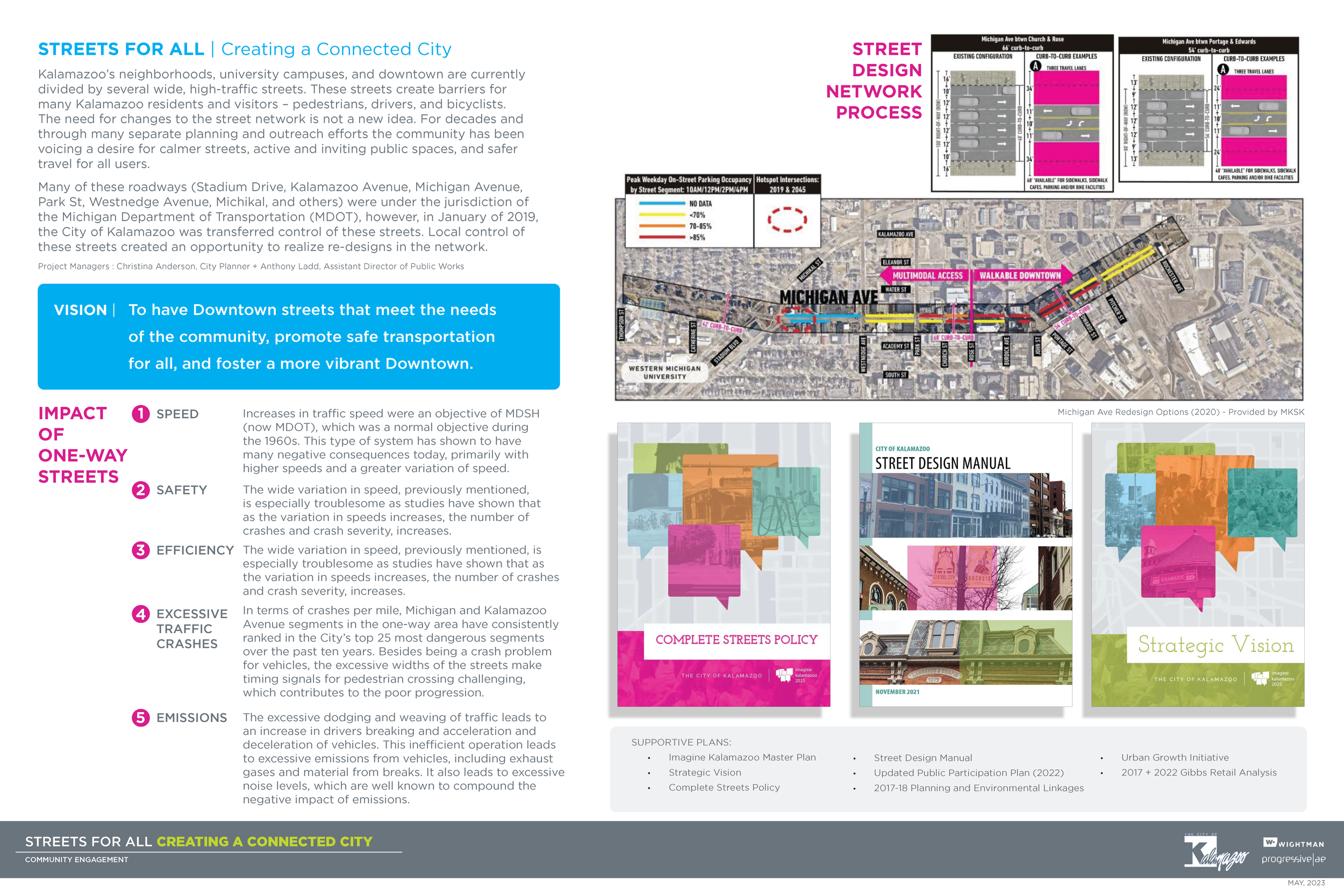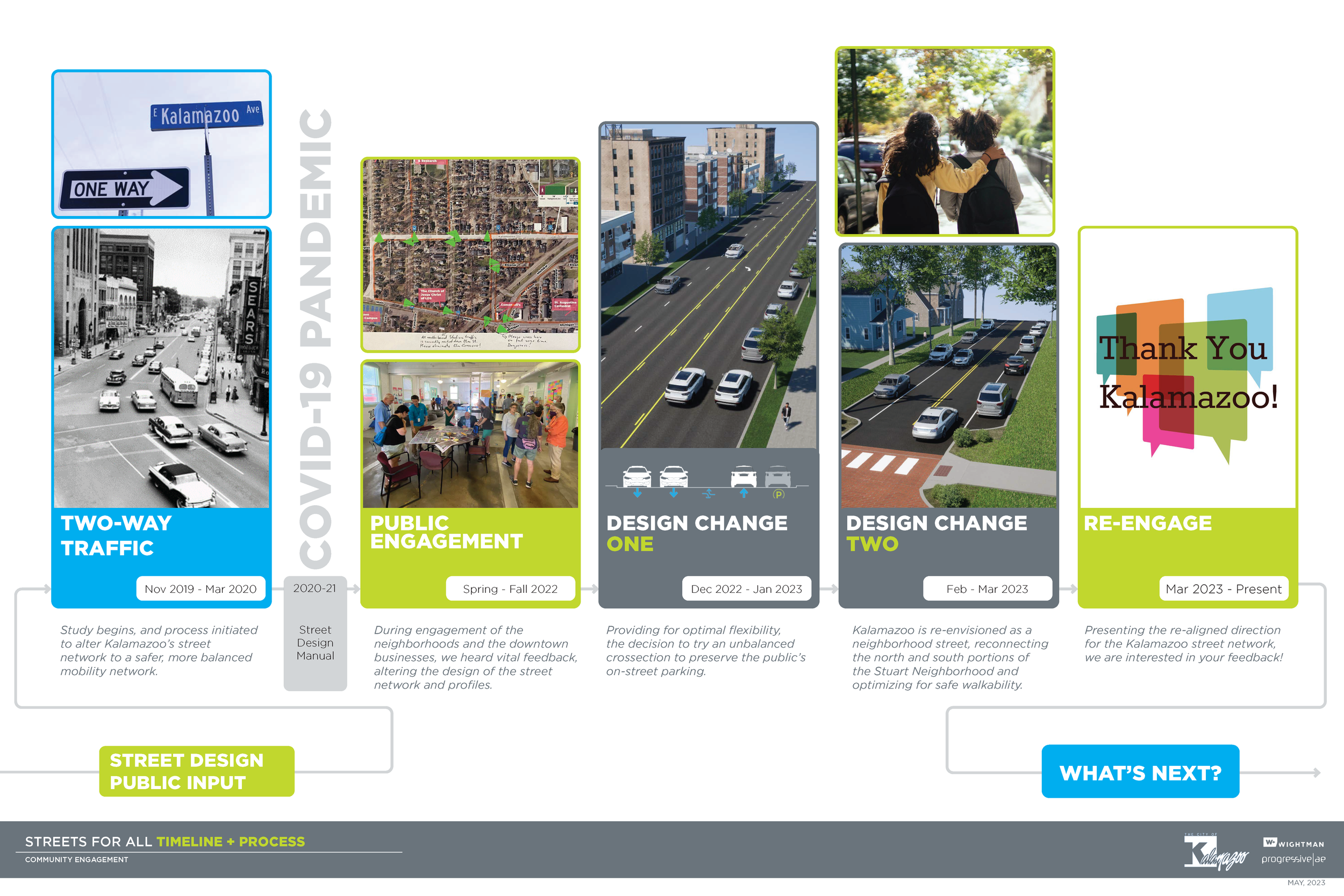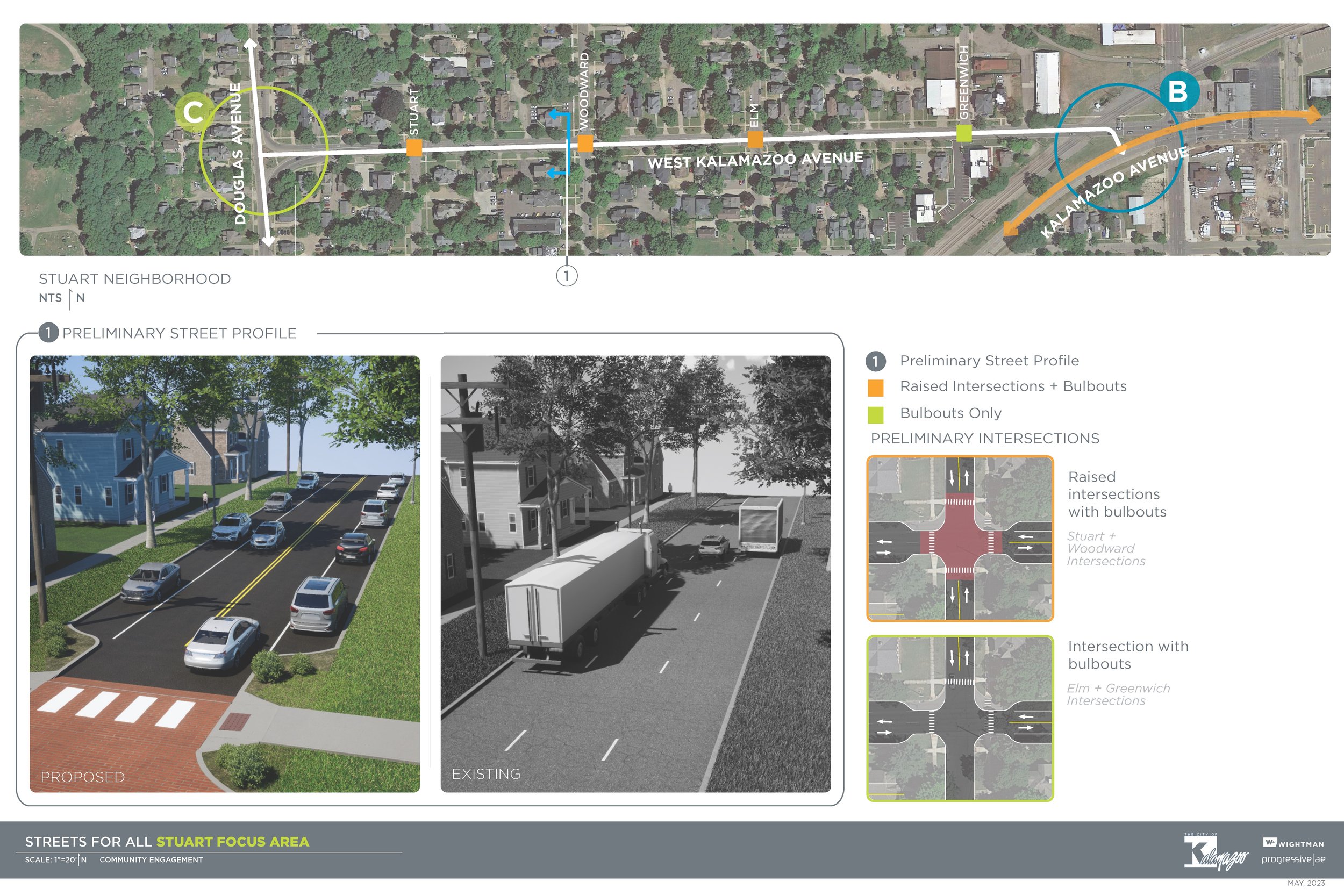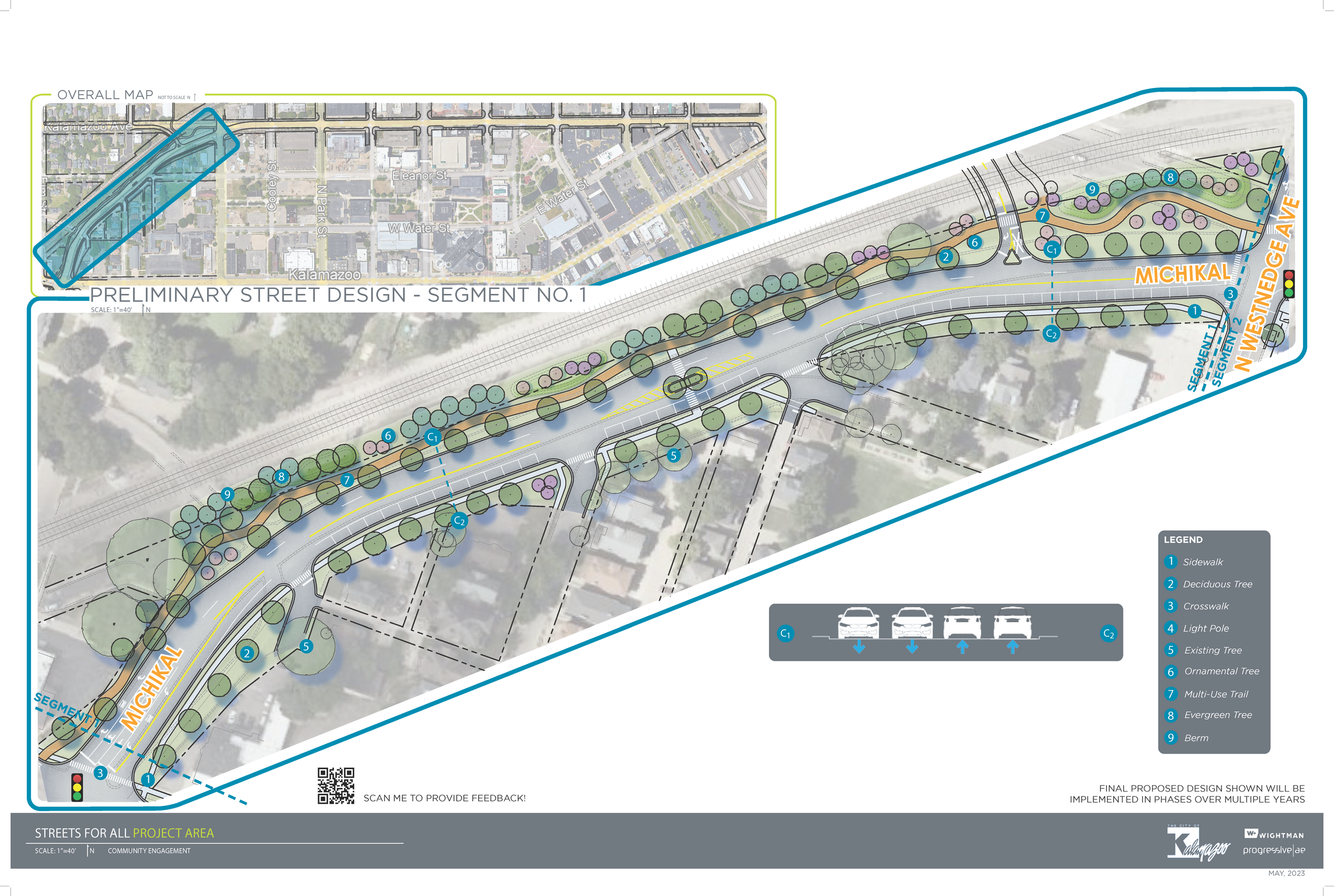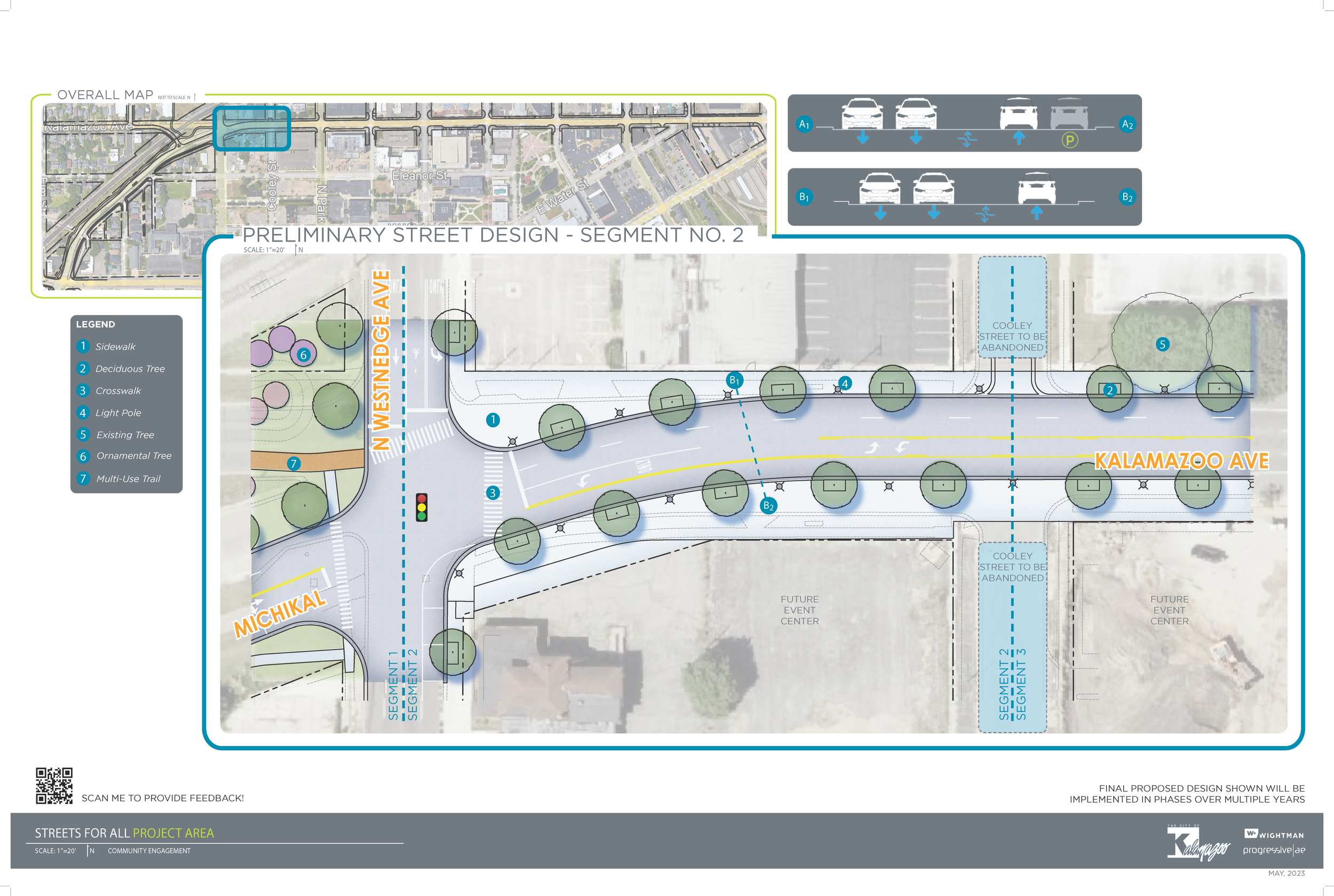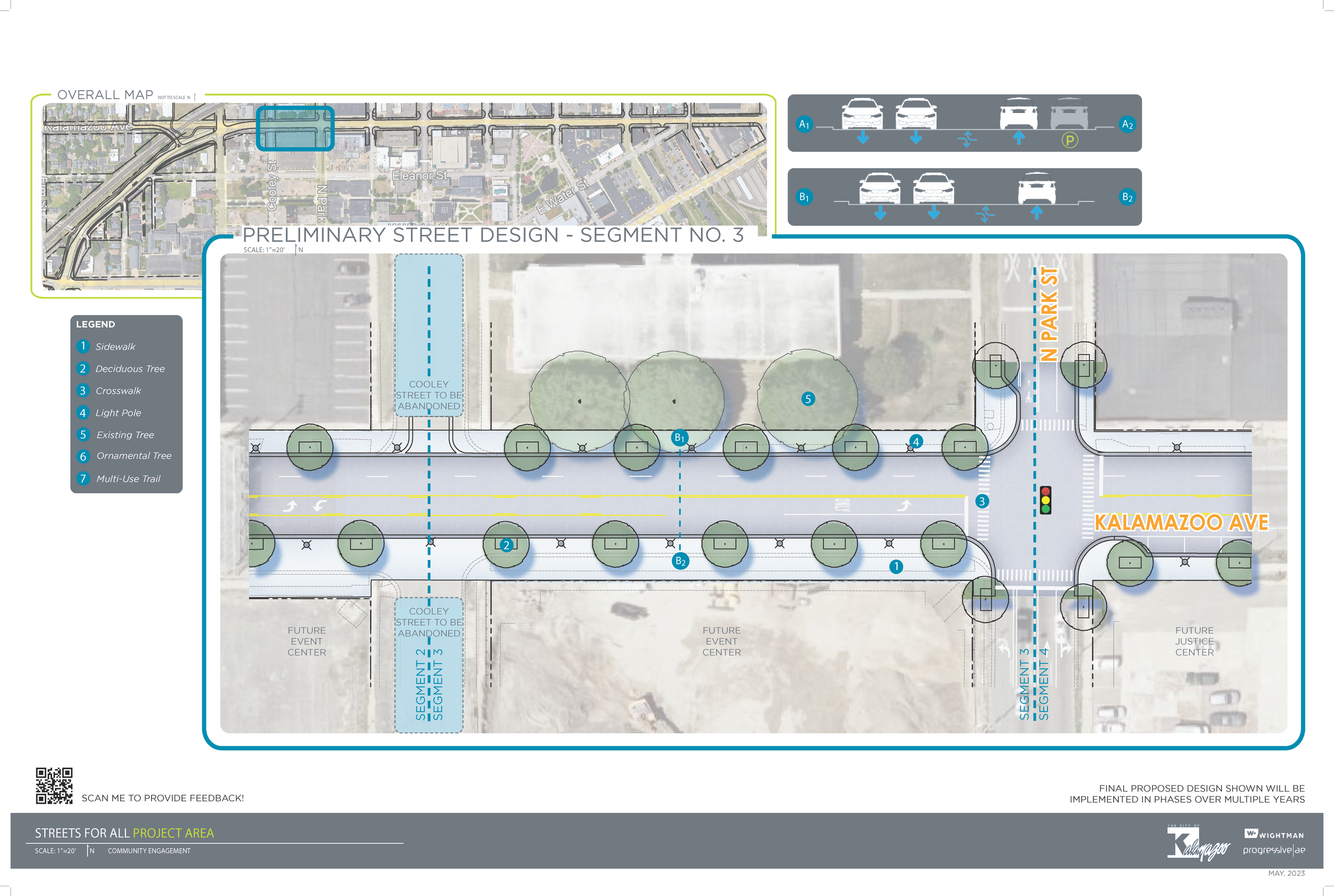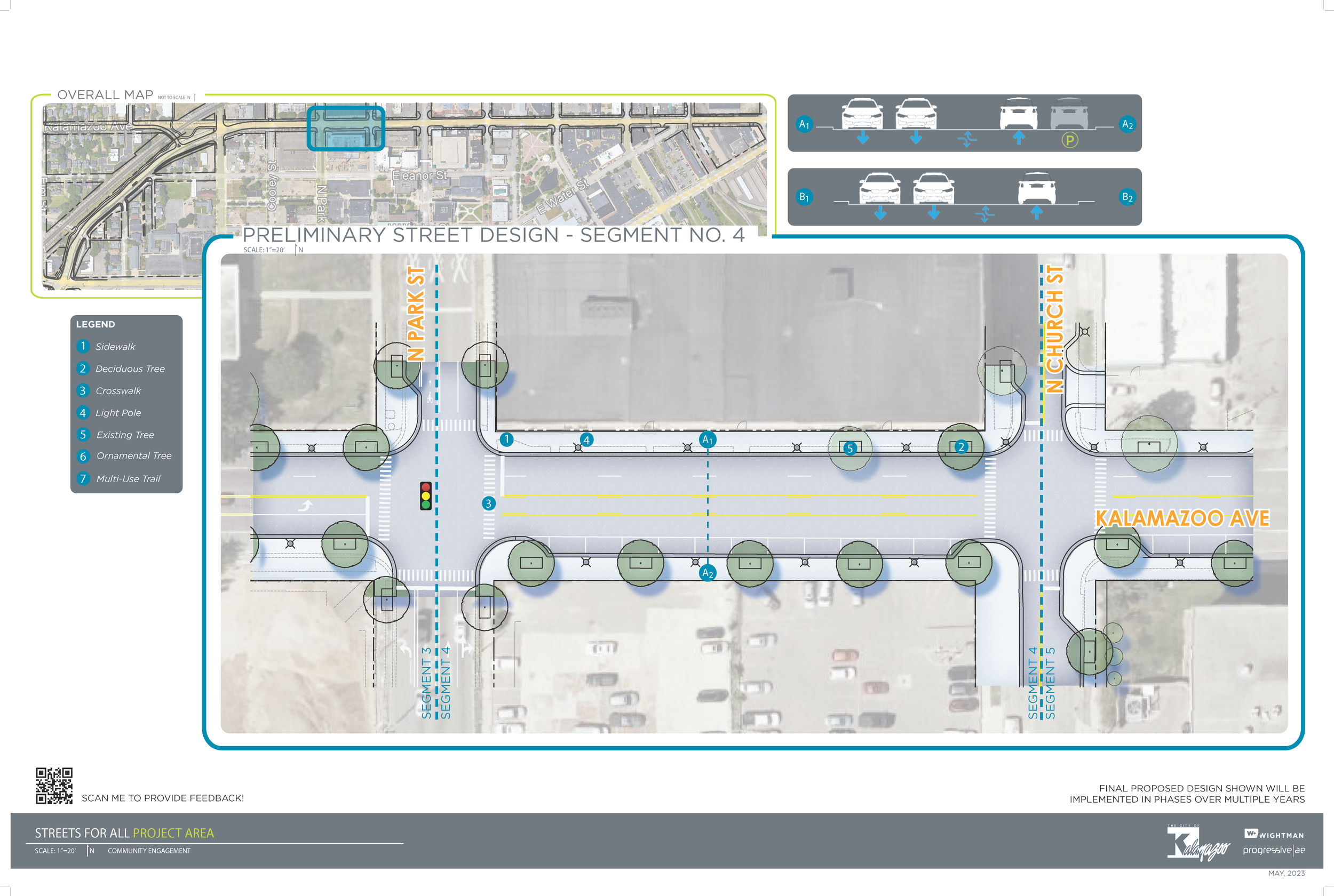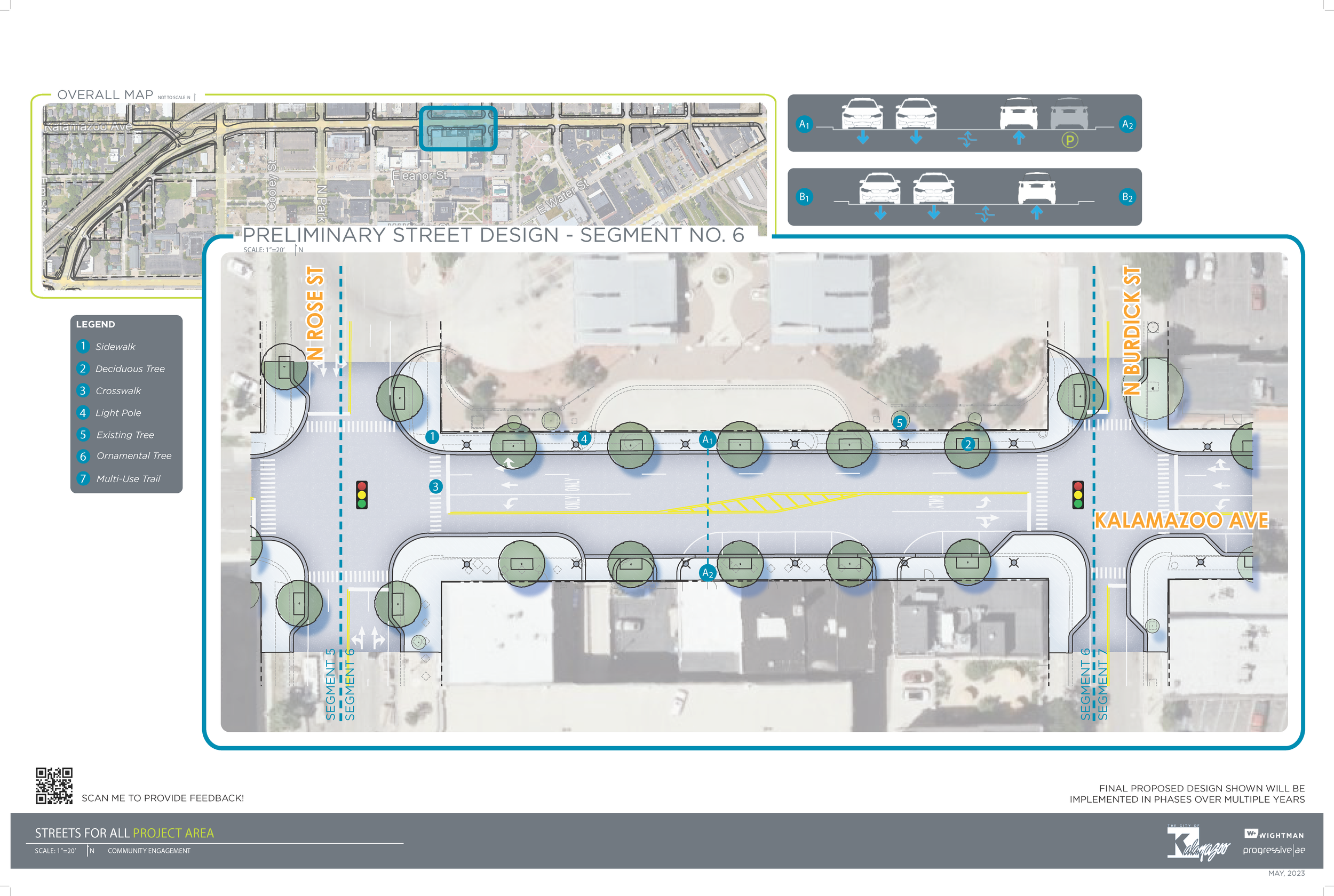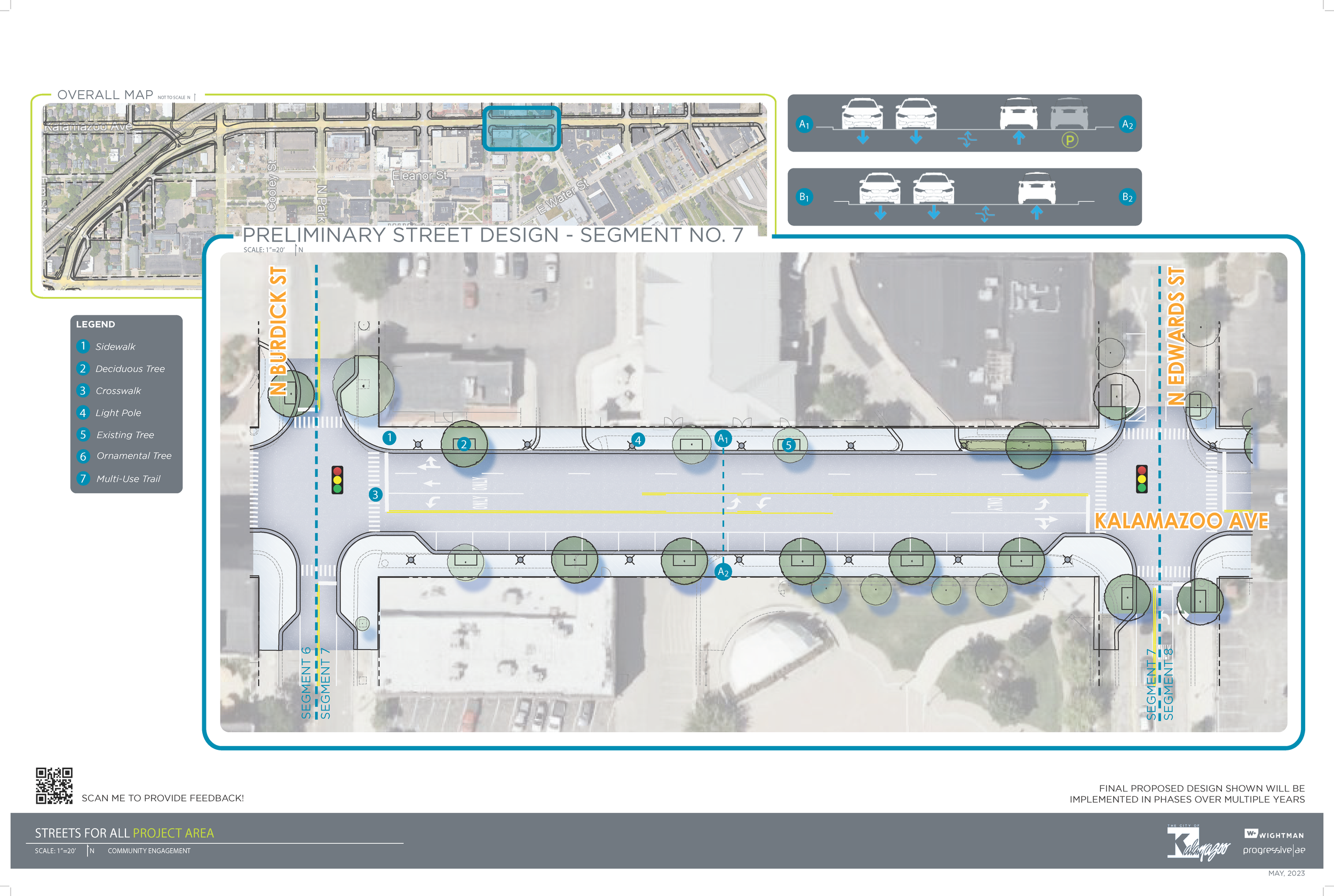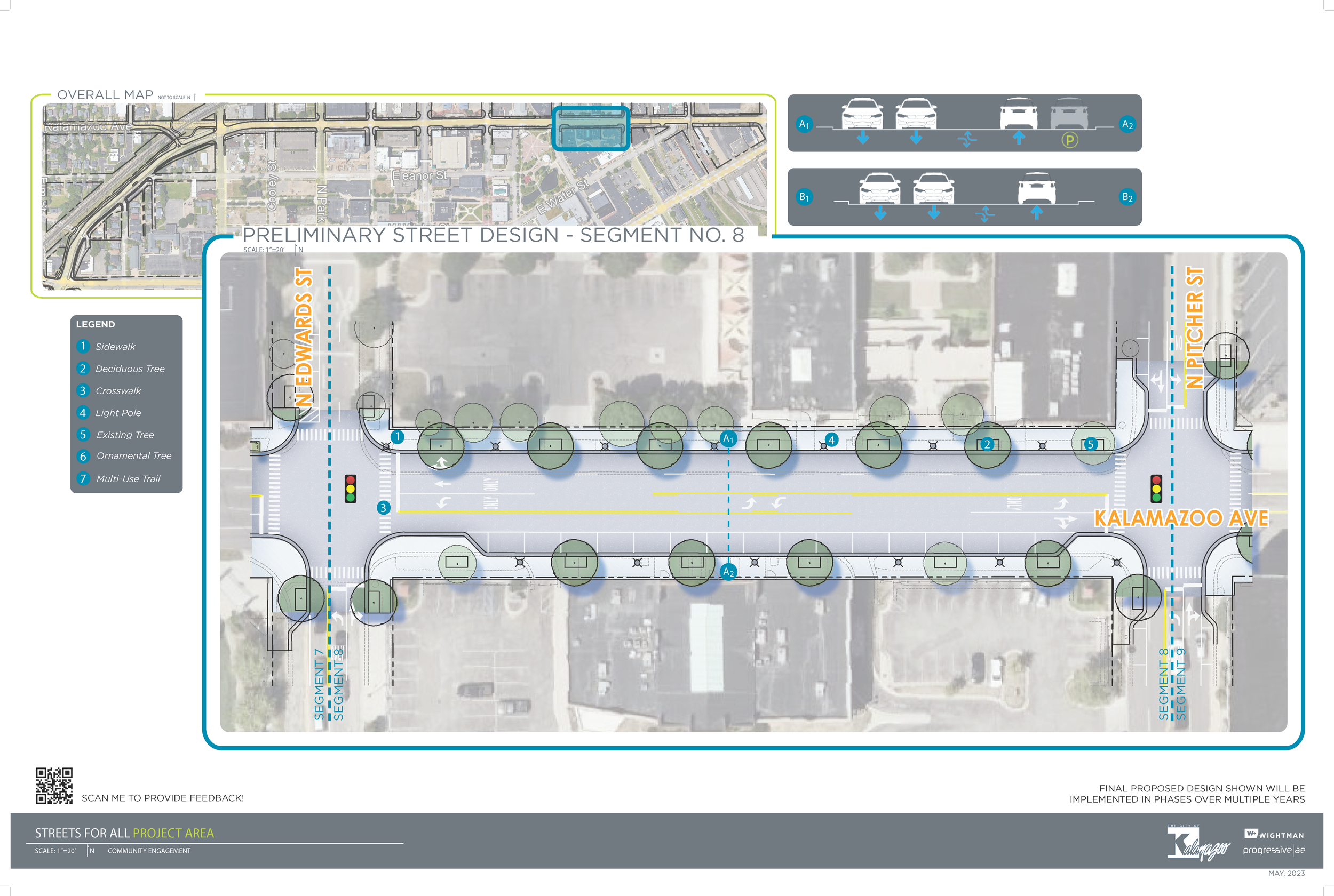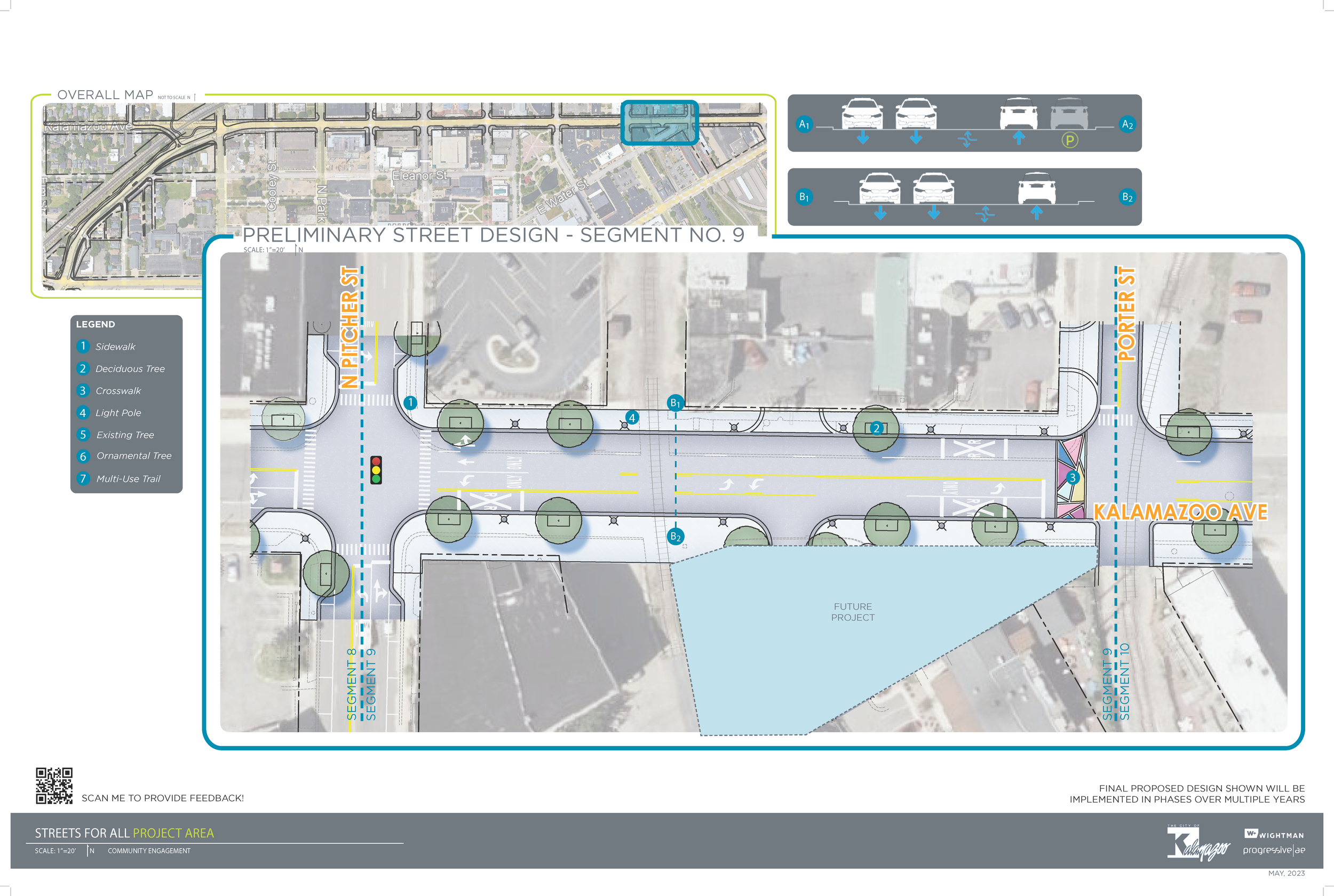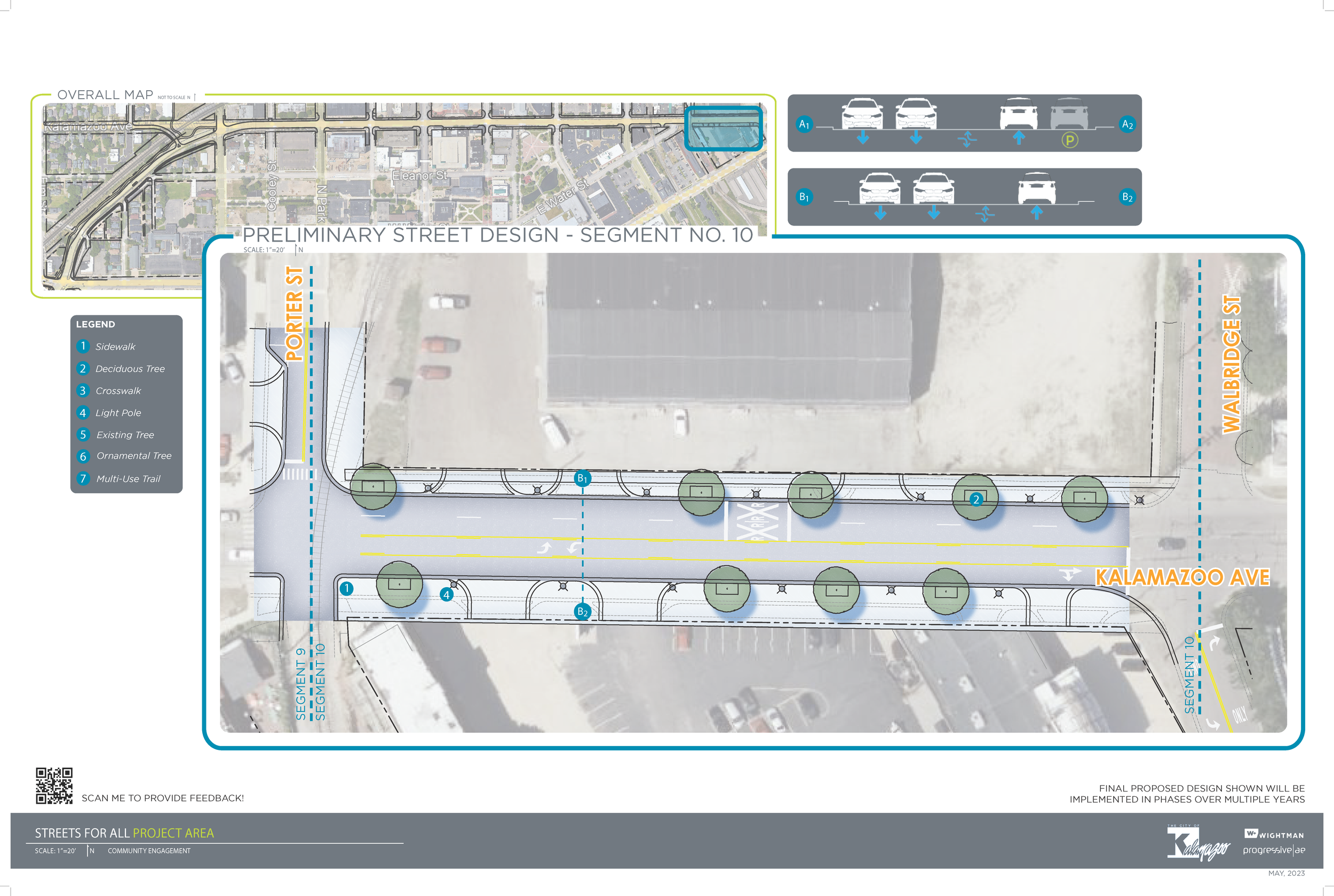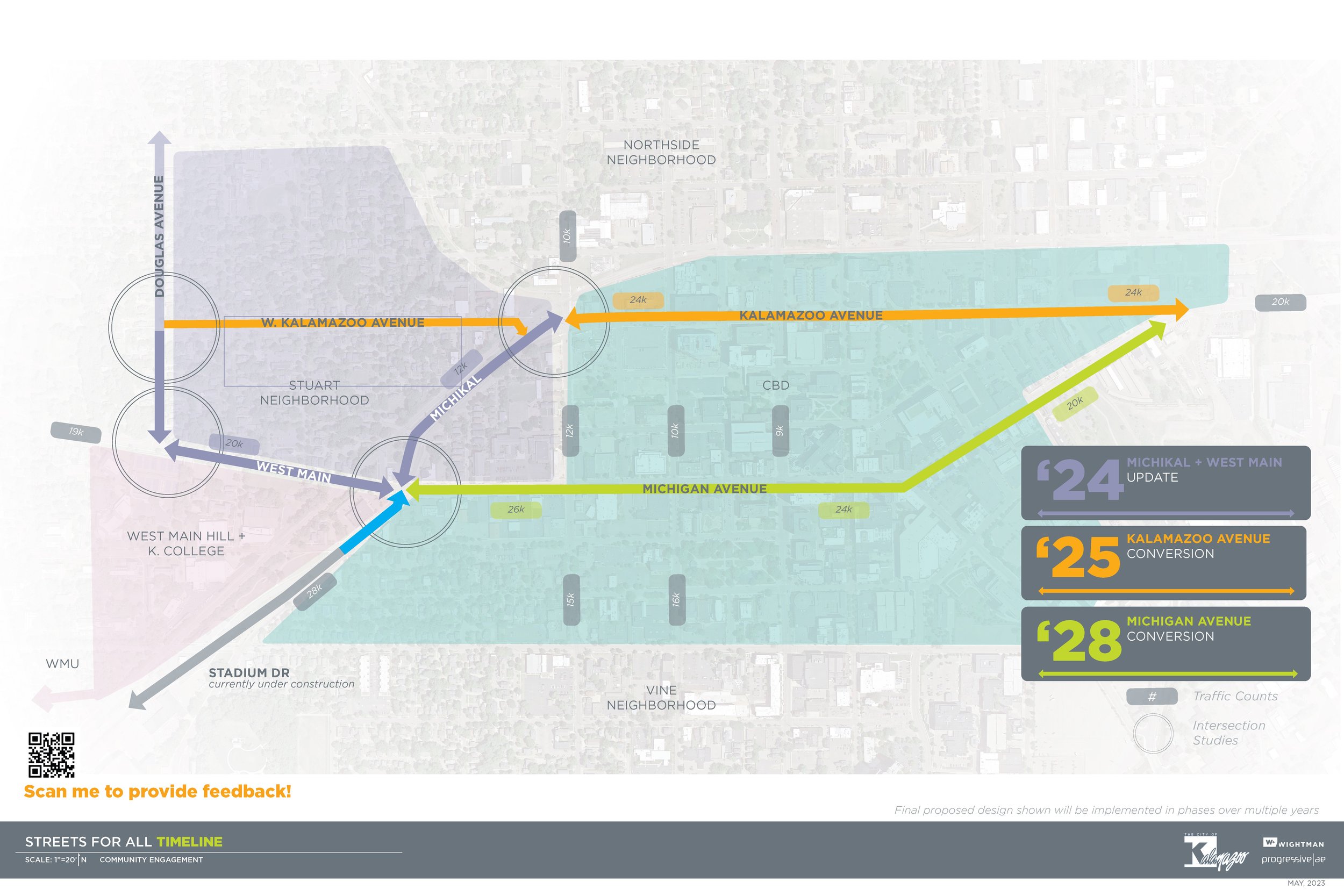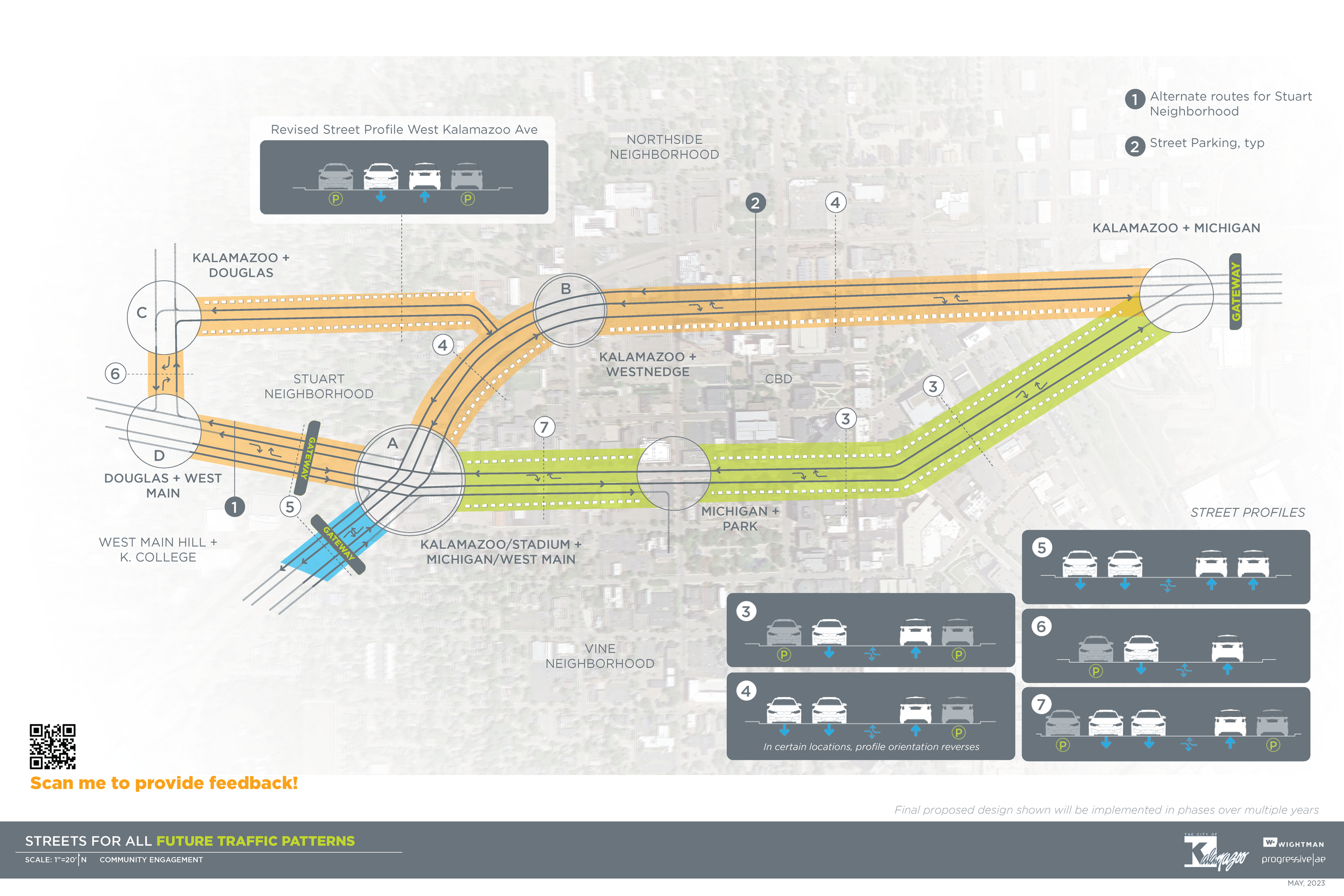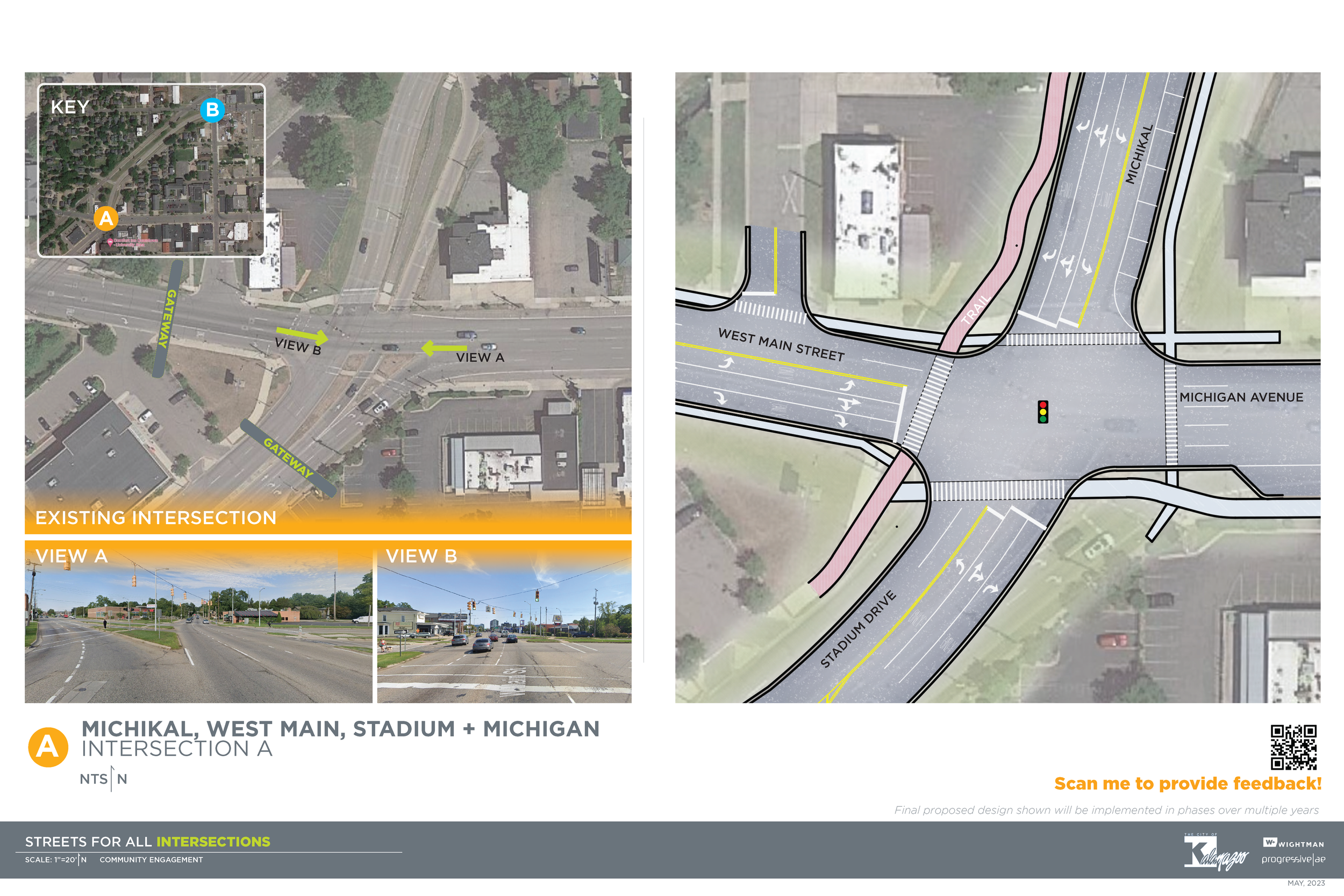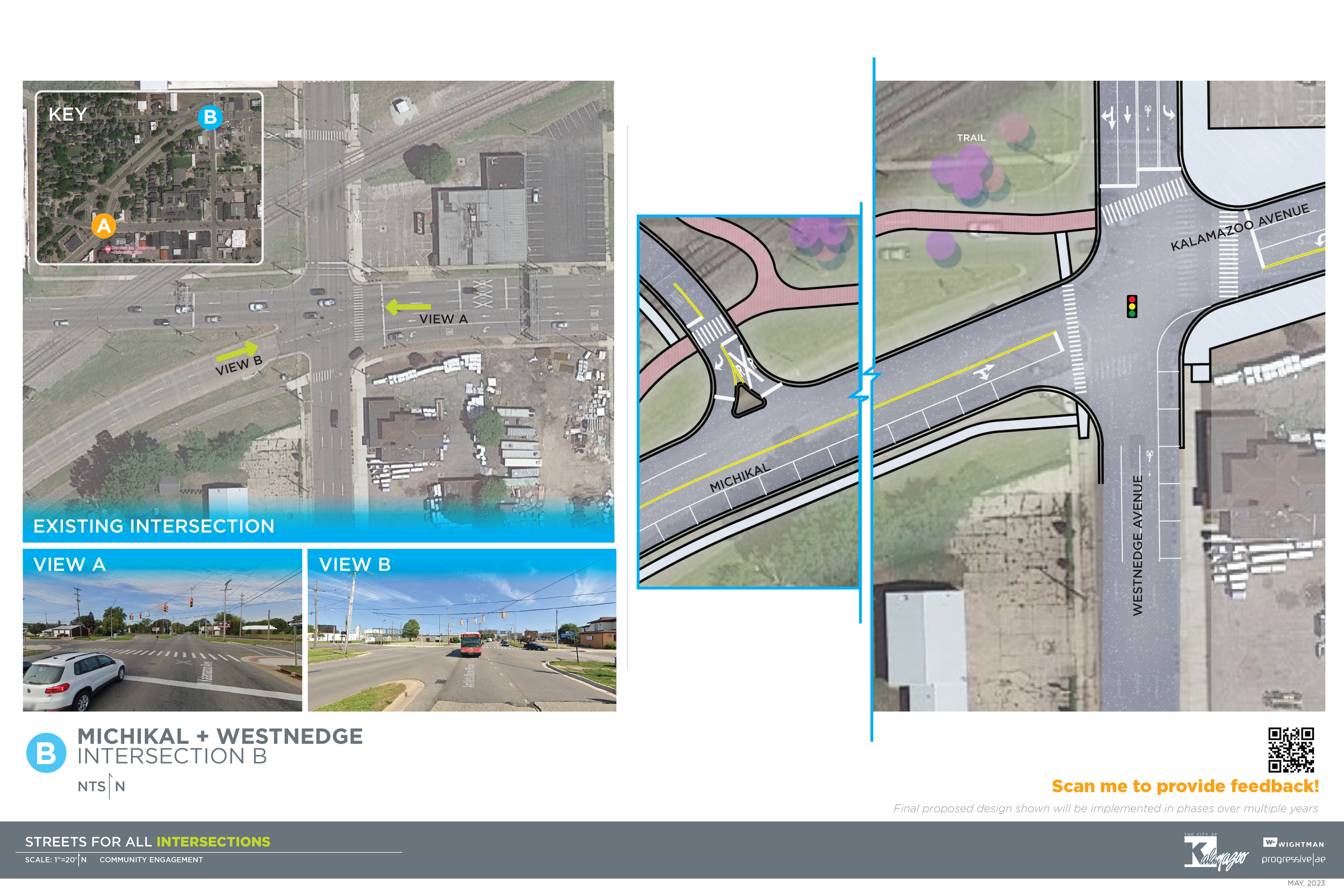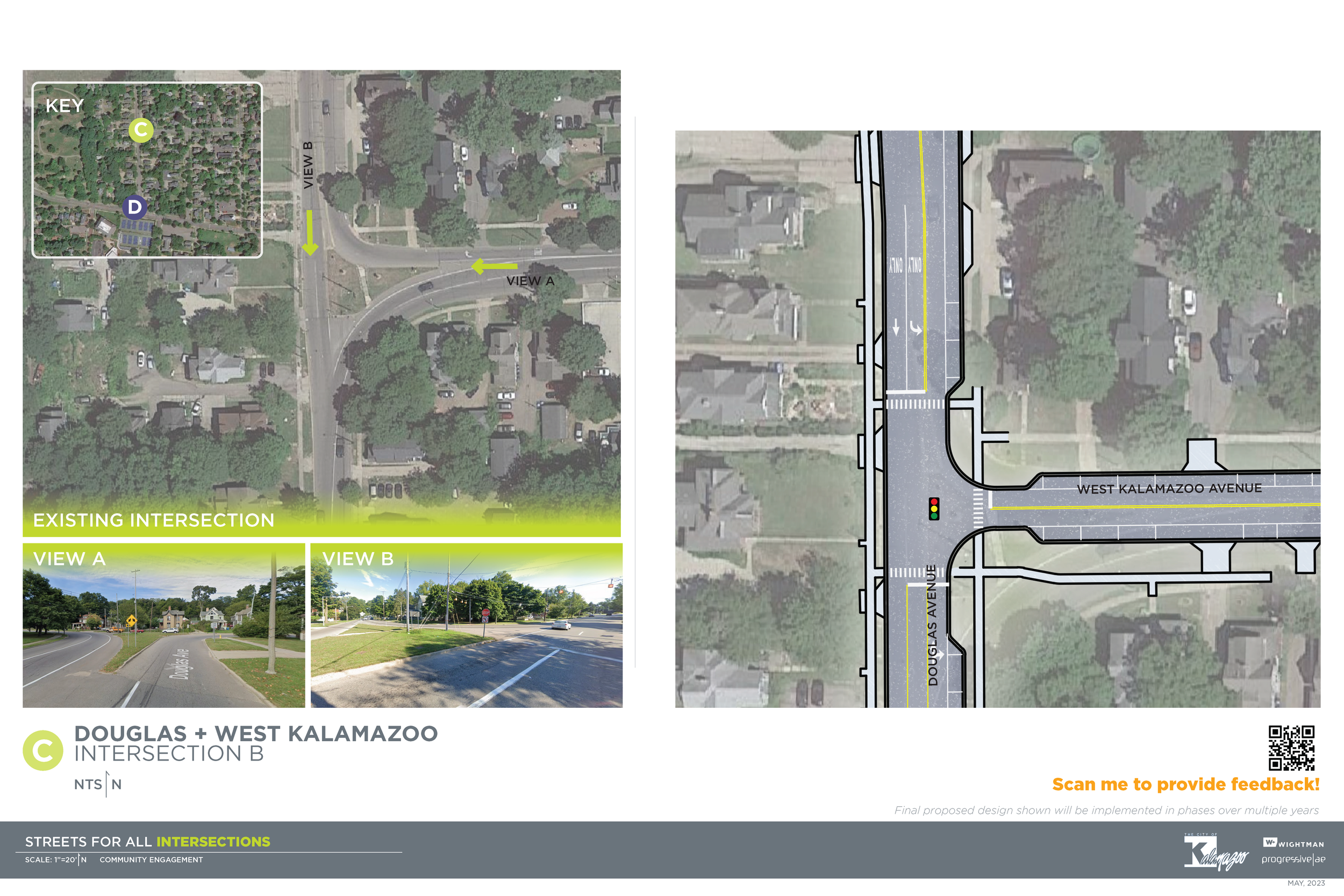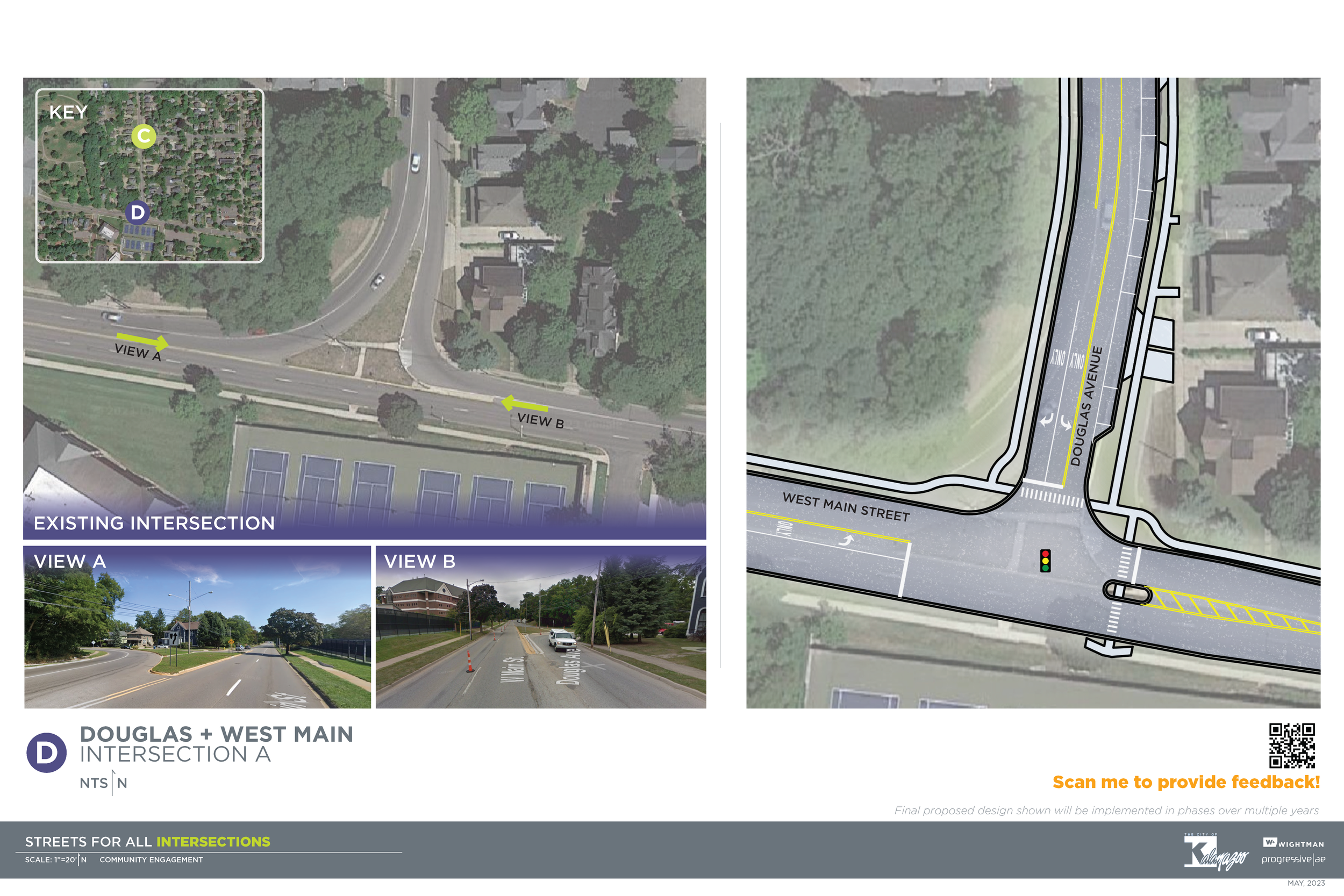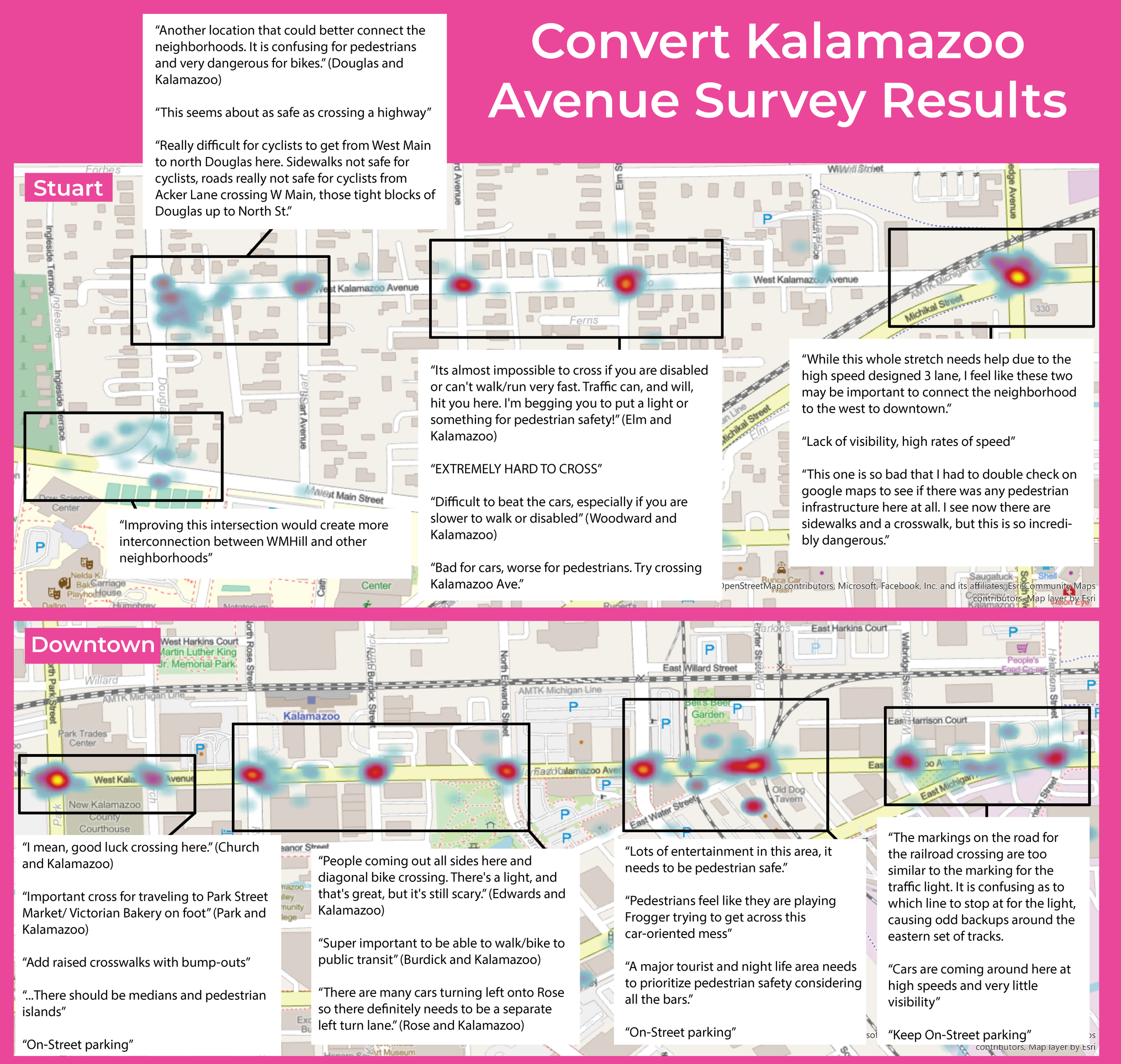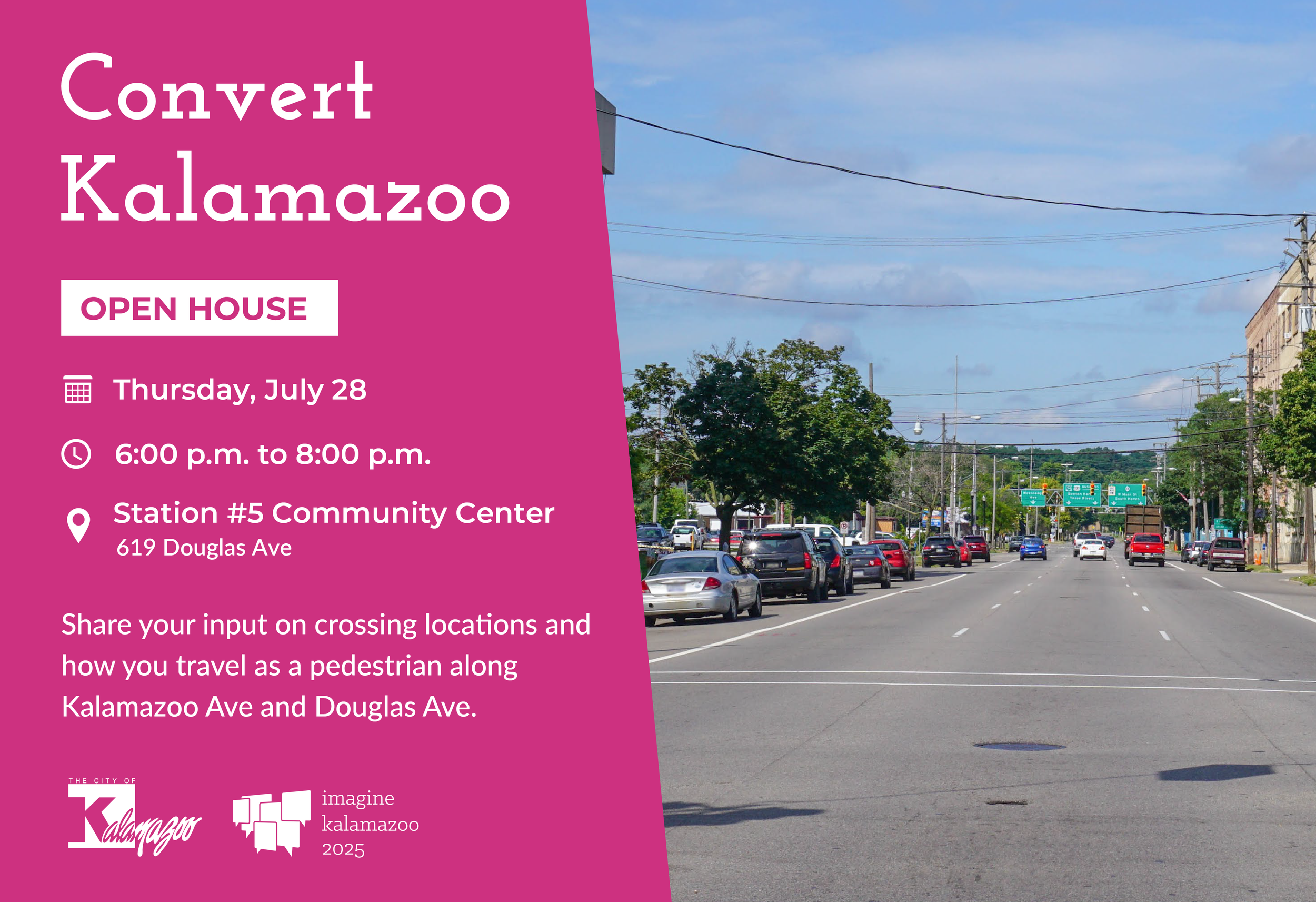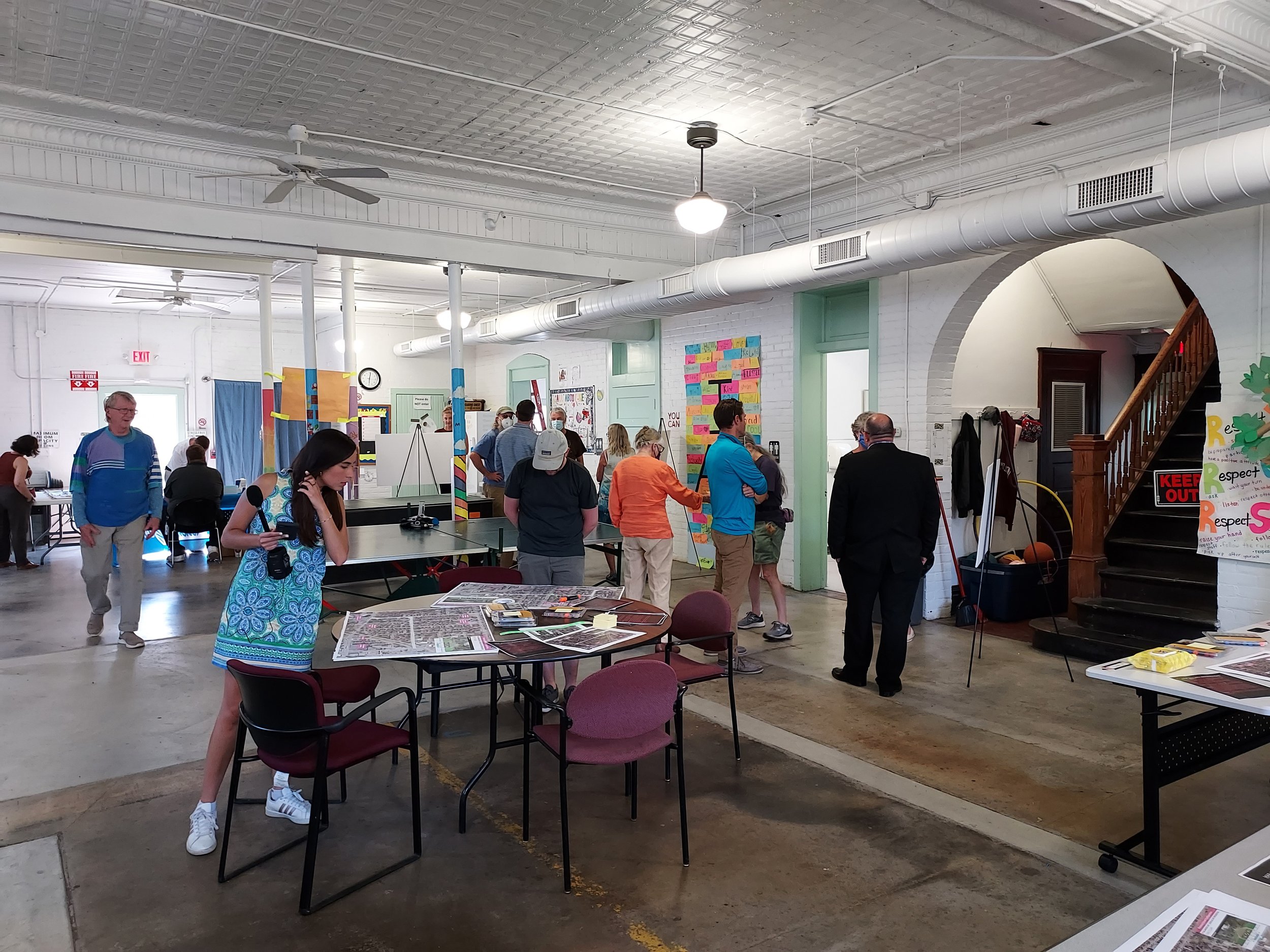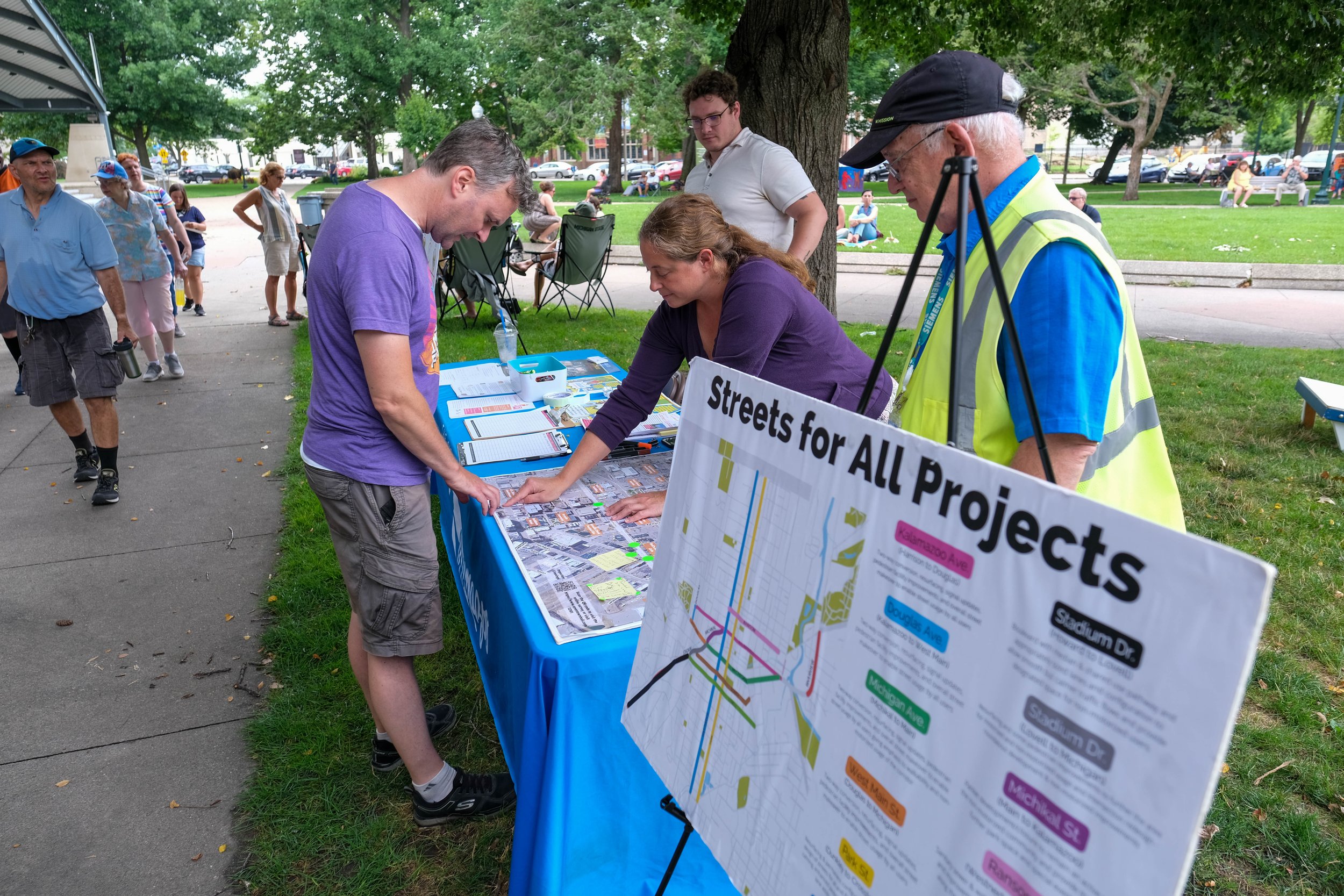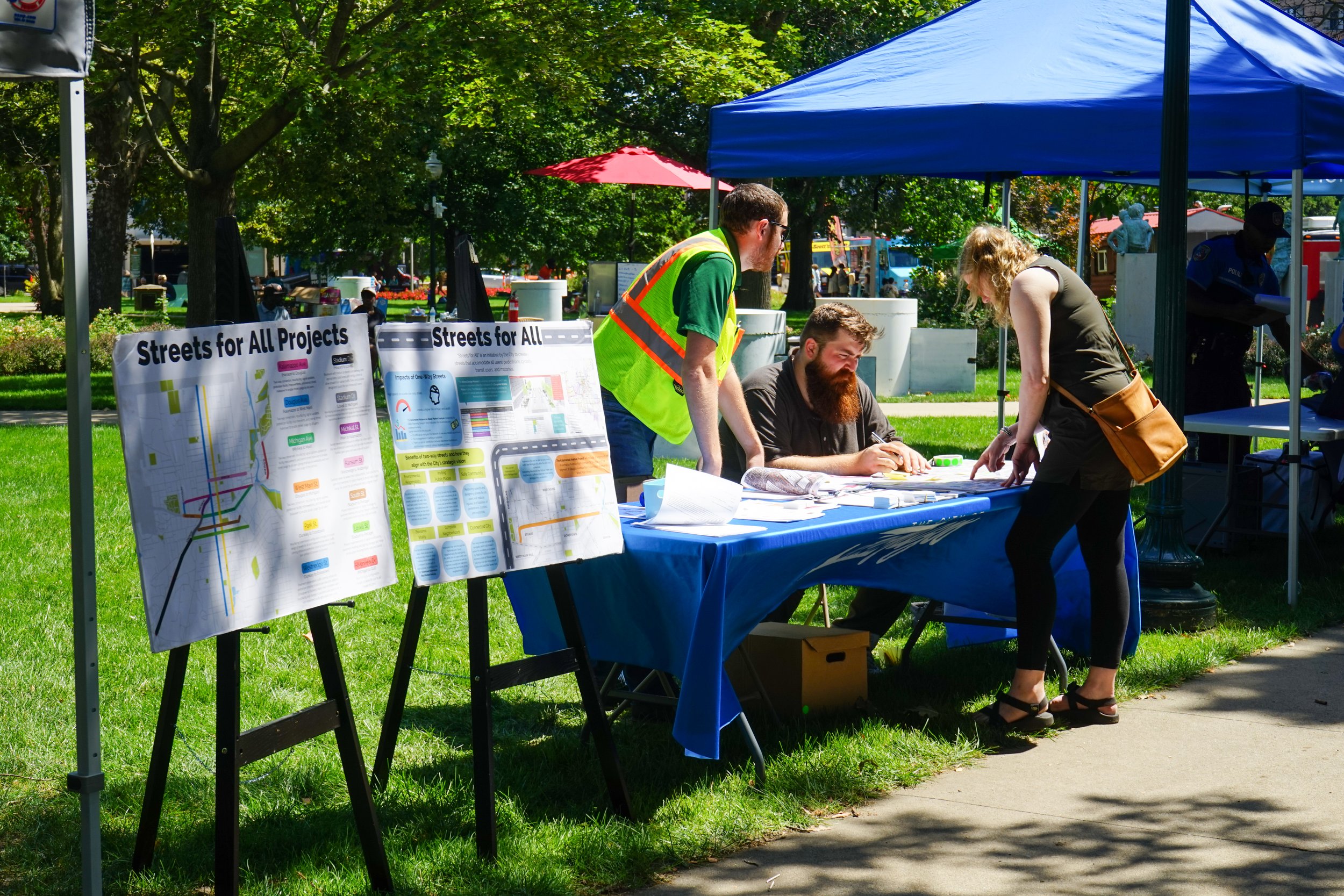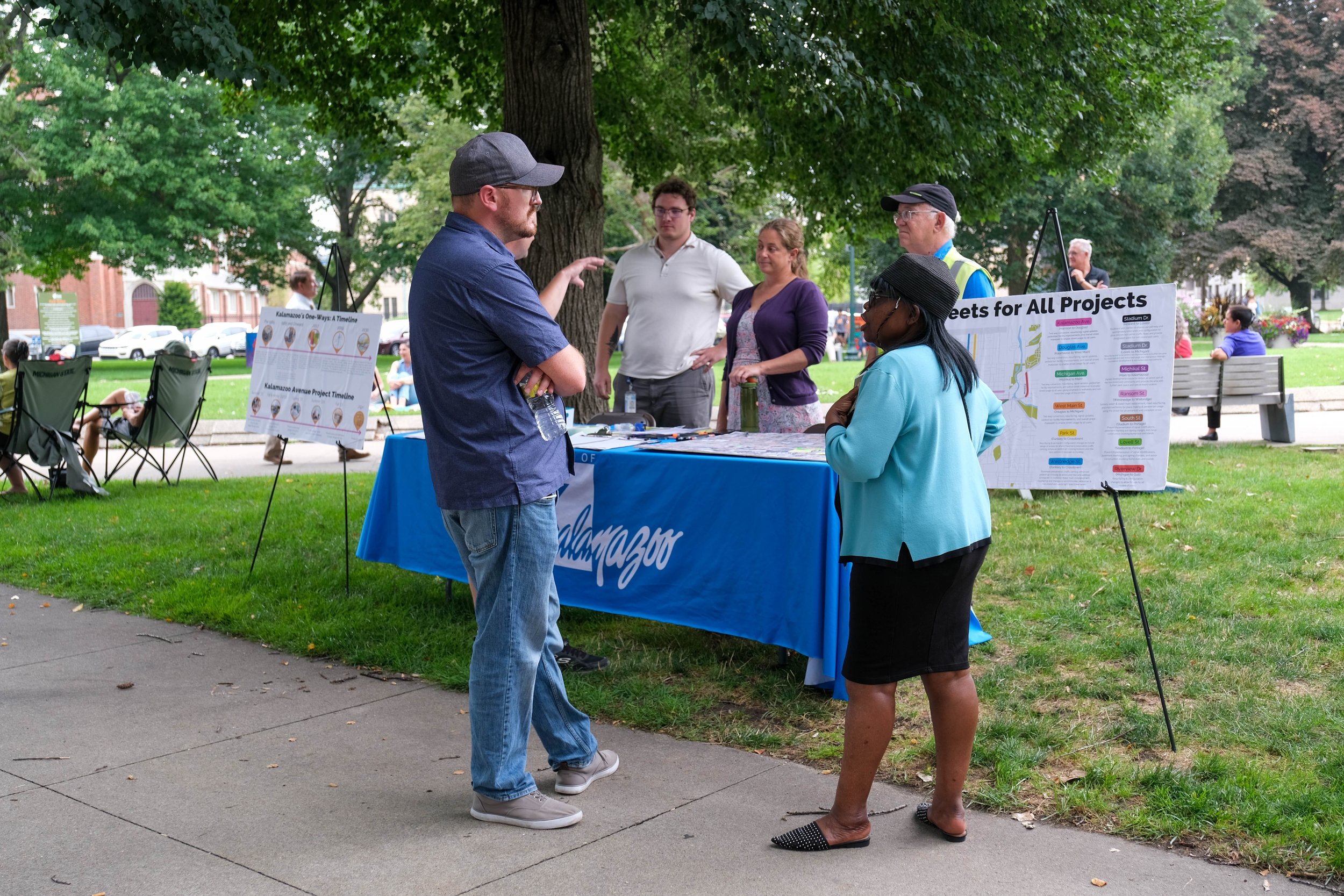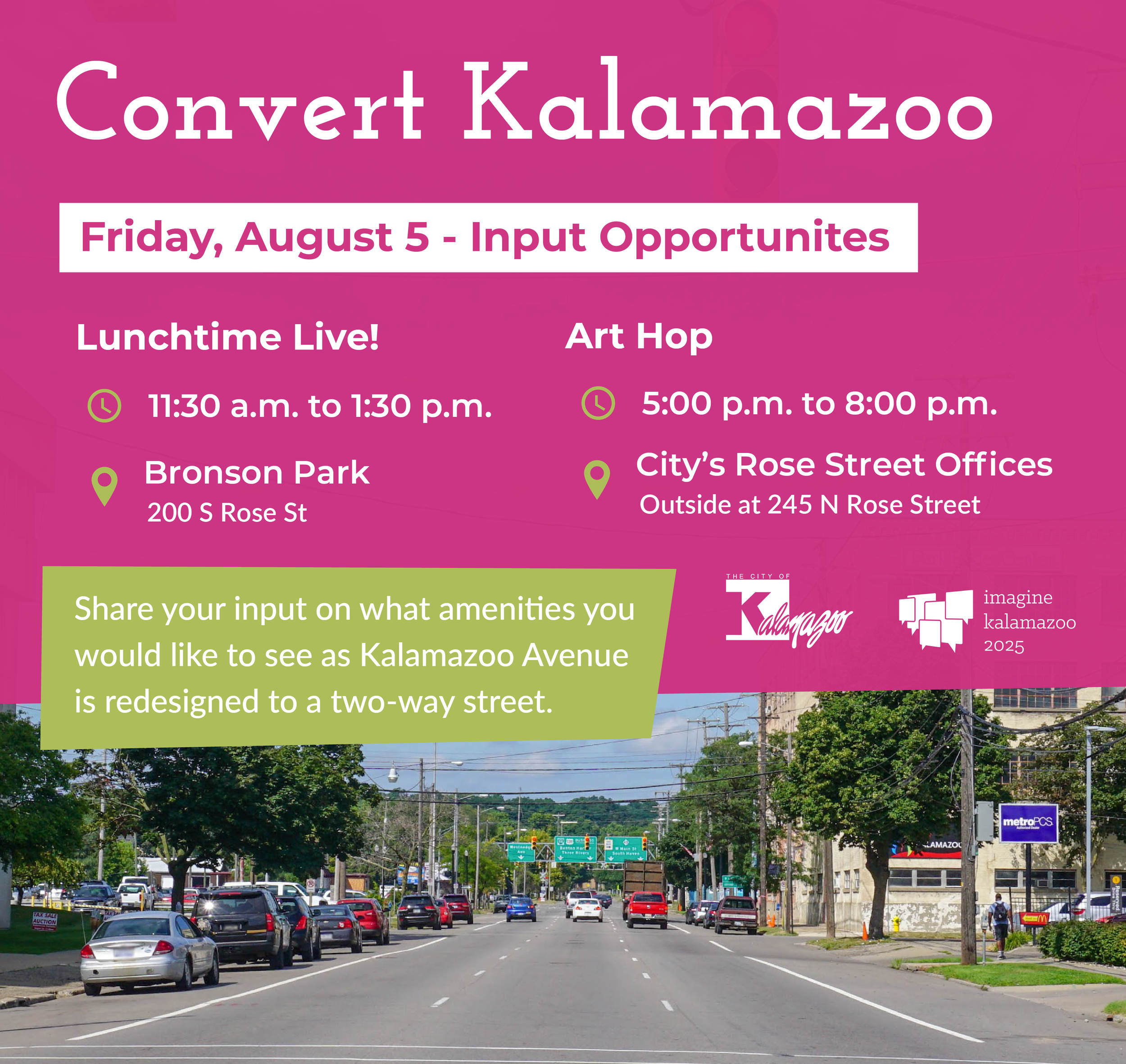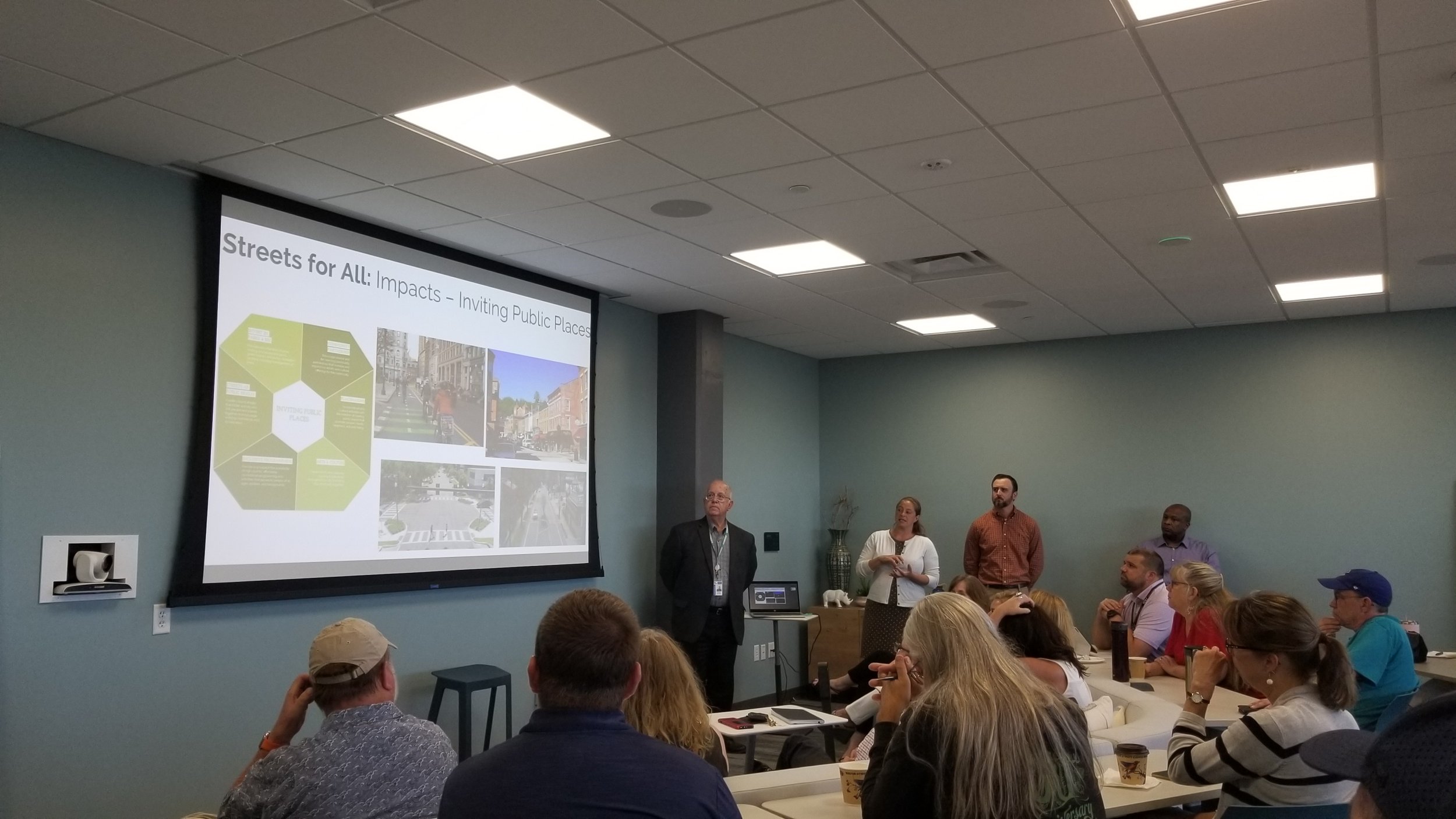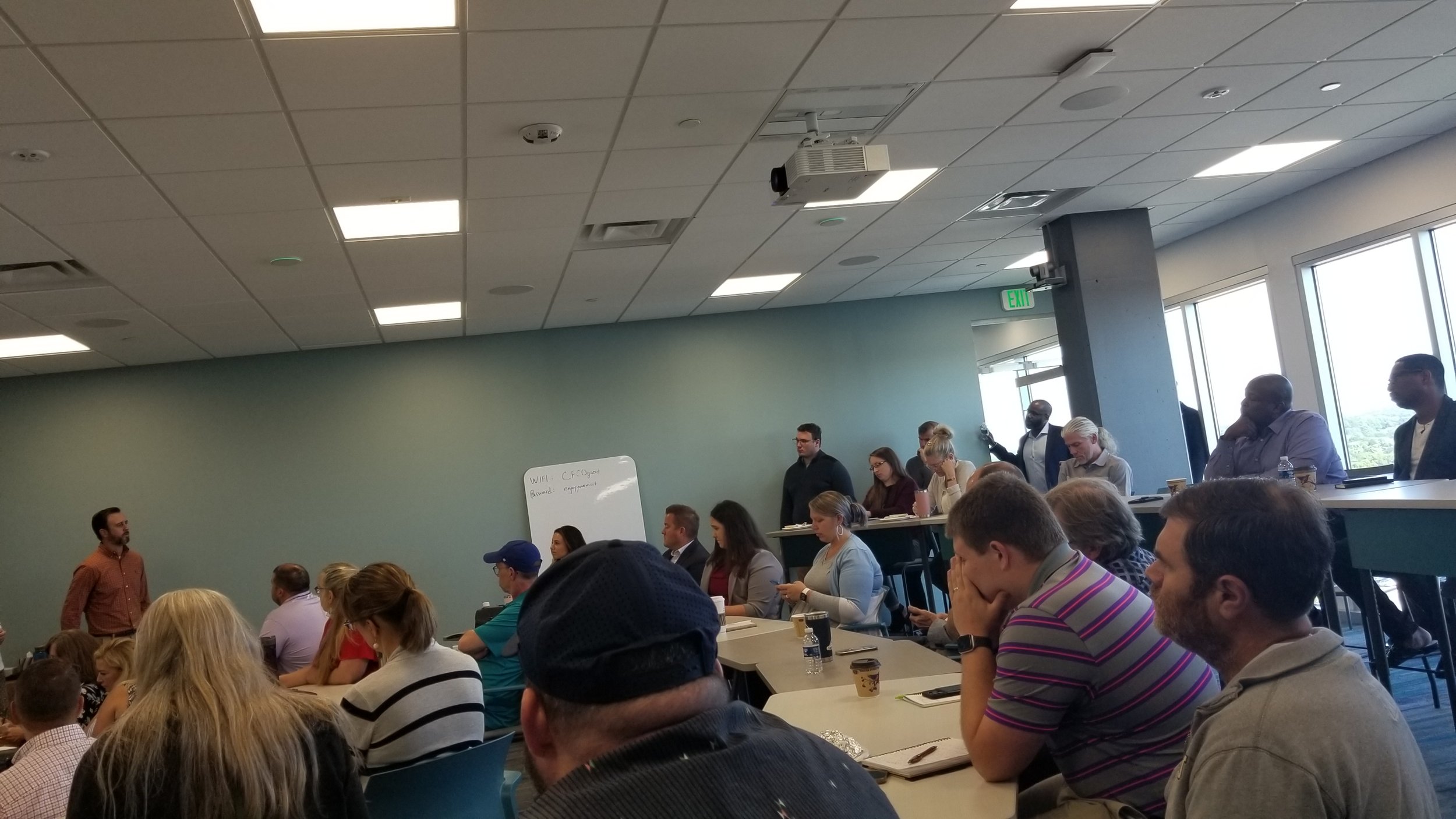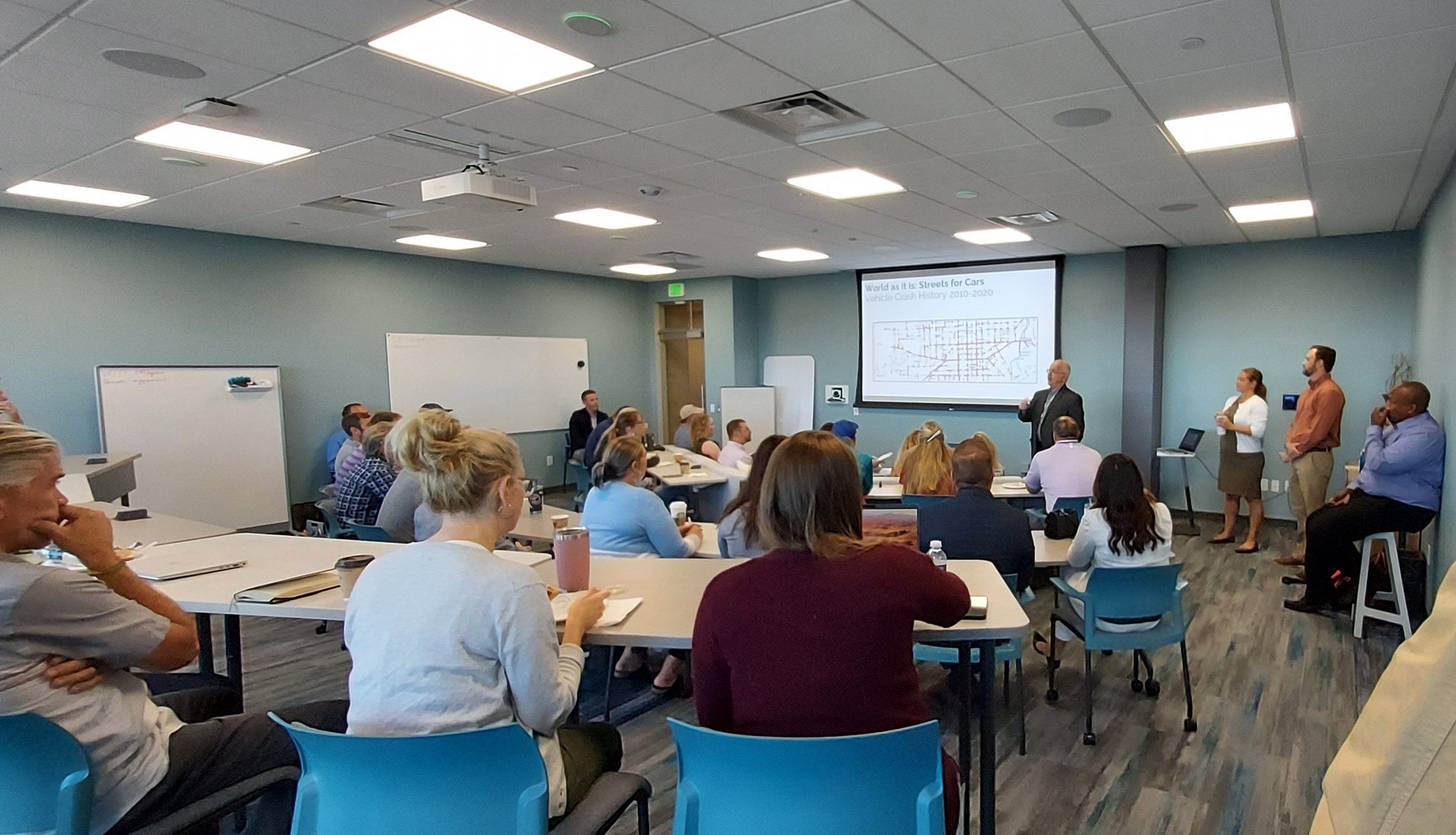In the News
Revitalizing Kalamazoo: Transforming One-Way Streets to Ignite Downtown Foot Traffic - June 22, 2023
Public and Private Investments Are Poised To Transform Michigan - June 15, 2023
$22M public benefit expected when 2 Kalamazoo streets turn to two-way traffic, study says - March 3, 2023
See which Kalamazoo streets will convert from one-ways to two-ways - Feb 21, 2023
Kalamazoo is ditching most of its one-way streets – back to the way they used to be - Feb 13, 2023
Converting Kalamazoo Avenue to a two-way street will likely benefit downtown businesses - July 31, 2022
Kalamazoo community voices opinions, feedback on Kalamazoo Avenue two-way street project - July 29, 2022
Converting one-way street to two-way traffic is topic of Kalamazoo open houses - July 26, 2022
City Commission approves designing Kalamazoo Avenue into 2-way street - May 16, 2022
Learn more about updates to Kalamazoo Avenue’s redesign below.
SUmmer 2023 Updates
Engagement boards from the Kalamazoo Avenue Open House Meetings are shown below. PDF copies are also available below.
Did you miss the Open House meetings? You can still provide input online here:
Kalamazoo Avenue Open House Public Feedback
You can pan around the board below and view the public feedback that was provided at the Kalamazoo Avenue Open House meetings.
Project Overview Video Series
Overview:
On Sunday, October 3, 1965, the Department of State Highways changed Kalamazoo and Michigan Avenues to a set of one-way streets. One-way traffic was predicted to move cars through Downtown Kalamazoo faster, which was the Department of State Highways’ priority. In this, it succeeded. Within a year the State measured speeds at 11 m.p.h. faster than before the conversion and with drivers having to make fewer stops when passing through Downtown. While vehicles moved faster through Downtown, economic vitality and travel to Downtown, especially by foot and bicycle, suffered.
Beginning in 2024/25, Kalamazoo Avenue will be converted back to a two-way street. This project follows decades of discussion, Imagine Kalamazoo’s goal of a Connected City, and transfer of control over streets like Kalamazoo and Michigan Avenues from the State to the City. In preparation, an 18-month design process is underway as of June 2022. The work planned for Kalamazoo Avenue goes beyond the above-ground, street work, to include an update of utilities, some more than 100 years old. Smart traffic signals, transit upgrades, and improvements to pedestrian movements are also planned as part of this project.
Map of Project Area
What is next in 2023?
City, Wightman, and Progressive AE staff are sharing draft plans during Spring and Summer 2023. A series of videos have been released providing project background and open house meetings scheduled for May 2023. The videos, project updates and meeting times and locations are listed below.
Report Out #1 — to the Stuart Neighborhood Board and Residents of the Stuart, Douglas, and West Main Hill Neighborhoods
Historic Stuart Neighborhood March Board Meeting (RSVP Link)
Mar 14, 6:00 PM
Woodward School, 606 Stuart Ave, Kalamazoo, MI 49007
Open House #1 - General Public Open House to Provide Project Updates
When? Wednesday, May 24 from 430 to 7 pm
Where? Bells Brewery, Backroom (355 E. Kalamazoo Avenue)
Open House #2 - Business Oriented Open House, General Public Welcome
When? Tuesday, May 30 from 9 to 11am
Where? Catalyst Center, Building Lobby (180 E. Water Street)
Learn more about Streets for All projects using the button below.
Read the Kalamazoo Street Design Manual using the button below.
Use the buttons below to navigate to the information you are most interested in.
What we Heard in 2022
Since July 2022, this project was discussed at meetings with neighborhoods, including Douglas, Stuart, West Main Hill, Northside, and Eastside; an Art Hop event; National Night Out events; Arcadia Festival Site open house; Downtown business-focused meeting; and lunchtime lives in Bronson Park. At the same time, an online survey was open asking the same questions as those in the live events.
All of this engagement generated specific themes helping guide the design team:
Inclusion of on-street parking in Downtown is a priority.
Clear, wide as possible sidewalks are desired. Consistent street trees are important.
Some of the priority intersections for north-south travel in Downtown are Kalamazoo & Westnedge and Kalamazoo & Porter/Pitcher
Some of the priority intersections for north-south travel in the Stuart Neighborhood are Douglas & Kalamazoo and Stuart-Woodward-Elm & Kalamazoo
Online Survey Results - 2022
How will feedback be used?
The consultant team of Wightman and ProgressiveAE will use this information to create the construction plans for the Kalamazoo Avenue corridor. The analysis of this information has already begun. At the start of this design process, the thought was that Kalamazoo Avenue would have 5-travel lanes: 2 in each direction and a center turn lane through Downtown (in Stuart, the section was and is planned to be a 3-lane section with 1 lane in each direction and a center turn lane reflecting its location through a neighborhood).
What was originally considered?
Based on the input received placing a high priority on-street parking, the plan for a 5-travel lane cross-section is being reconsidered.
In its place, we are studying a cross-section with two westbound travel lanes, one center turn lane, one eastbound travel lane, and one lane of on-street parking. This is referred to as an unbalanced section with two travel lanes in one direction and one in the other. An illustration of the unbalanced intersection is shown below.
The unbalanced street section is shown above from a top-down view. The orange area is outside of the curb-to-curb area. The configuration would be four lanes. Two lanes would be westbound, one eastbound, with a center turn lane.
If you are interested in learning more about the project, please watch the October 17th Committee of the Whole City Commission Presentation below.
How does this affect other projects?
This project and all of the Streets for All projects are designed with the whole network function in mind, therefore design work on Michigan Avenue (and South, Lovell, and Stadium) will take this in mind. Michigan Avenue will be considered for an unbalanced section with two eastbound lanes and one westbound lane, at least leading into Downtown from the west.
What are the next steps?
The first set of draft plans for the Kalamazoo Avenue corridor will be shared for review and public comment this spring. We will be sharing any additional information and updates with you as they are available.
Engagement Overview
Engagement events and stakeholder meetings were held throughout the Summer of 2022, starting with a kick-off event in July and continuing into August. Other smaller stakeholder meetings continued into the Fall.
July 28th - Station 5 Kick-Off Event
City staff and consultants engaged with residents of Douglas, West Main Hill, Stuart neighborhoods on Kalamazoo Avenue, specifically focused on key pedestrian crossing locations. Activities included a mapping exercise, 1:1 conversation, and a walking audit along Kalamazoo Avenue.
August 2nd - National Night Out
City staff engaged with residents of the Northside neighborhood on Kalamazoo Avenue and other city initiatives and programs during the Northside Association of Community Development’s National Night Out event. Activities included a mapping exercise, 1:1 conversations and a lego table.
All of August - Lunchtime Live!
City staff hosted an informational booth at Lunchtime Live! throughout August with a mapping activity and 1:1 conversations.
August 5th - Art Hop
City staff and Consultants hosted a booth and engaged with Art Hop participants. Activities included a mapping exercise, 1:1 conversations and an artistic activity about envisioning a different Kalamazoo avenue.
August 19th - Arcadia Creek Festival Site
City staff and Consultants hosted a tables and engaged with residents at the Arcadia Creek Festival site. Activities included a mapping exercise, 1:1 conversations and games.
August 31st - Downtown Business Forum
In partnership with Southwest Michigan First, City staff and Consultants invited and hosted a presentation for Downtown Business Owners with an engaging question and answer session following the presentation. Close to 50 representatives of Downtown Businesses took part in the event.
FREQUENTLY ASKED QUESTIONS
These questions have been answered by Public Services and Planning staff.
Q1: Has the decision to convert certain streets from one-way to two-way been finalized?
Yes, converting these streets and updating others in and around downtown are in align with the City’s support of IK2025, the Master Plan, Complete Streets Policy and two Economic Development Studies by the Gibbs Planning Group in 2017 and 2022 and national trends. Exactly how the conversions happen, and the timeline are still being worked out. However, Staff estimates it will take 10-15 years to complete work on all the Streets for All projects. Kalamazoo Ave is the first street planned for conversion to two-way traffic. Outreach and design began in June 2022 and will run through December 2023.
For a map of streets included in this work, go to http://www.imaginekalamazoo.com/projects/streetsforall/
Q2: Why is Kalamazoo Avenue being converted from one-way to two-way traffic alongside other projects in the future?
Answer: The one-way network implemented in the City in the mid-1960s by the State Highway Department had one primary purpose, moving as many vehicles as quickly as possible through the Downtown Kalamazoo area with a minimum of stops.
These objectives were not intended to provide access to businesses, commercial, residential, or other activities along Downtown Streets. They were done in an era when people and goods were moving to the suburbs creating the suburban enclosed malls we see today. This shift of people, goods, and money hurt Downtown and the one-way streets helped facilitate this shift.
The State Highway Department also neglected that the one-way streets cut through residential neighborhoods with many pedestrians who were not provided safe crossings or walking facilities. Due to this, one-way streets create hazardous conditions for those attempting to enter or leave their properties or to cross the wide lanes with fast moving traffic at wide-ranging speeds.
Source: Dangerous by Design 2022, page 7. Full Report Here. Similar conditions are seen on Kalamazoo and Michigan Avenue.
By providing more direct access to properties along the new two-way streets, and making streets easier to travel across and navigate, we make the streets and the area more inviting and safety for all types of businesses as well as residential and general community activities.
The conversion of one-way streets to two-way is much more than just a change in traffic operations, it is a change in how the City as a whole and its Downtown will look, live and feel for future generations. This is the time to take advantage of this once in a lifetime opportunity to reshape the City. It is necessary to implement these changes and think about the safety of all users.
Other Cities with completed or plant to complete one-way to two-way street conversions:
Q3: What is the intended result of these conversions?
Answer: Through these conversions and other street changes, we will make a safer and more livable community for all our residents, visitors, and businesses IF we thoughtfully consider the following components:
Safer and more comfortable travel environment for all users – person vehicles, transit, pedestrian, and cyclists.
Needed utility upgrades – many of these streets projects include an upgrade of underground utilities, some of which are among the oldest in the City. This includes sanitary, storm, and drinking water infrastructure.
Better support of the Downtown’s economic vitality (other examples of this and further reading here)
Improved connectivity between Downtown, adjacent neighborhoods, and institutions such as WMU, K College, and Bronson Hospital
Source: Are We Strangling Ourselves on One-Way Networks?; Pedestrian - Motorist Conflict Zones (Two-Way vs One-Way intersections)
Q4: Can you be more specific about how this will support economic vitality?
Answer: Economic studies done in 2017 and 2022 have shown that improving the Downtown street network and making downtown easier to navigate for all users could help bring as much as $20 million more in retail sales and more than 50,000 square feet of new or expanded retail space. Those studies also described that one of the largest barriers to Downtown Kalamazoo is its one-way street network.
Source: Are We Strangling Ourselves on One-Way Networks?; Retail Eclipsing phenomenon
Q5: Has outreach on the redesign process started? Who is involved and for what reasons?
Answer: Yes, throughout August 2022. For Kalamazoo Avenue, outreach means both informational outreach and input-seeking outreach. Staff will focus on gathering comments and feedback on key north-south intersections and crossings to support connections between Northside and Downtown, as well as across the halves of the Stuart Neighborhood. Additionally, Community Planning and Economic Development, and Engineering staff will seek input on how to best use the space in the right-of-way in the street not used for vehicle travel lanes.
Q6: When will construction begin on Kalamazoo Avenue?
Answer: Community Planning and Economic Development and Public Services staff estimate that construction on Kalamazoo Avenue will start in 2024 and will be a two-year process with work occurring between Harrison Street and Douglas Avenue. Besides Kalamazoo, we will also have follow-up projects on Michigan Avenue, Lovell, possibly North and South Streets and finally at the intersection of Stadium Drive and Lovell. If funding is available, these projects will extend over the next 8 to 10 years.
Q7: What is the total cost for the construction part of this work?
Answer: Final construction costs have not been determined and will depend on a range of factors, including the extent of underground utility work included as part of the project.
Q8: Will the traffic be slower due to either design or speed limit changes or both?
Answer: Current conditions show as much as 70 percent of all drivers go faster than the posted (legal) speed limits. This behavior of disregarding speed laws makes streets very unsafe and highly unlivable. Traffic is intended to be slowed by the roadway re-design to match the posted speed limit. We will review speed limits will be reviewed, but no changes are anticipated at this time. The speed limit for Kalamazoo Avenue from Walbridge to Westnedge is 30mph and 35mph from Westnedge to Douglas.
Source: Adapted from (Tefft, 2011) Collision speed survivability vs vehicle speed
Q9: People currently use these streets to get from one part of the city to another, via downtown. Will there be better or alternative routes to using downtown as a cut-through?
Answer: Repairing the traditional street grid of the City, and two-way traffic flow will provide more options when traveling to or through the area. The primary improvements on Kalamazoo and Michigan Avenues will help repair the grid alongside improvements on Lovell, North, South, and Ransom Streets, all intended to facilitate the east-west traffic and create a more effective grid.
Our studies show that we can accommodate traffic. We will have much safer speeds, less traffic noise, and fewer emissions making the entire area more livable. Current analyses show that for the average driver during peak periods, the time to travel from Harrison to Douglas will only increase 2 to 4 minutes. We are also planning and making improvements to north-south streets in the corridor. These streets have been neglected to accommodate the Michigan and Kalamazoo one-way schemes. Improvements to our north-south streets will allow us to retime signals and to optimize traffic flows so traffic generally flows better in all directions.
Q10: How will it impact parking?
Answer: Parking is essential to a commercial corridor and to a downtown. Updating the parking system, including ramps and on-street parking, will occur parallel to the one-way to two-way conversions. Parking will be considered during every phase of planning and design. During the engagement process, parking has been a concern. We will use these comments to help shape the best design possible, considering all the competing needs and wants of the downtown area and the City as a whole.
We have not yet determined the exact changes to parking. That is part of the activity of planning and designing the conversion project.
Q11: How much of the cost of this work is direct from Kalamazoo city or county taxpayers? How much is covered by state, federal, or other funds (and how much for each)?
Answer: Funding for these projects will come from a variety of sources. City staff is working closely with Kalamazoo Area Transportation Study (KATS) the area Metropolitan Planning Organization that assists in distributing state and federal funds for infrastructure projects. We are especially interested in obtaining federal highway funds for these improvements. These competitive funding opportunities return funds to Kalamazoo residents that might otherwise go to other communities across the Country.
Project Manager(s):
Anthony Ladd, Assistant Director Public Works Division
Christina Anderson, City Planner
Objectives:
• Upgrade utilities, such as water and storm sewer, to better serve residents and businesses along the Kalamazoo Avenue corridor.
• Support travel by transit, on foot, and by bicycle to allow all safe and comfortable travel.
• Right-size the vehicle travel lanes for a Downtown and neighborhood City Street.
• Improve pedestrian movement, especially north – south travel to create stronger connections between the Northside neighborhood and Downtown and between halves of the Stuart neighborhood.
• Align land use and transportation to support successful businesses, healthy neighborhoods, and livable communities
Vision:
To redesign Kalamazoo Avenue to support travel safely, and comfortably by not only personal vehicles, but by transit, on foot, and by bicycle.
Schedule:
June 2022 Contract Awarded for Re-Design
June - September 2022 Engagement on Kalamazoo Avenue Redesign
October - February Data Compiling and Design Review
Spring 2023 - Report out Draft Redesign of Kalamazoo Avenue
Contractors:
Wightman & Progressive AE - Kalamazoo Avenue Re-Design Contract (Re-Design Kick-off starts in Summer 2022. Project continues into 2024)
Consistent with Plans:
Connected City, Safe Community, Inviting Public Places, Complete Neighborhoods are all goals addressed by Street Network Re-Design and Implementation efforts.
Completed in 2021, the Street Design Manual is the guiding document for the Complete Streets Policy outlining the need for streets for all, designed for safe, reasonable traversal by bicyclists, pedestrians, and motorists. It is a holistic approach and will be applied in practice during the re-design of Kalamazoo Avenue.
2017-18 Planning and Environmental Linkages (PEL) Study
Gibbs Planning Group 2017 retail market analysis and 2022 Analysis
Multiple market analyses point to how a change in our street network in the Downtown could have a positive economic impact by creating an environment that is a destination.
Funding:
$955,035 for re-design work only split into two-phases. Phase I will include $279,595, Phase II will include $675,440
$22 million from the Reconnecting Communities Pilot Program (Federal) for capital costs (Michigan and Kalamazoo Avenue)

